Advanced Legal Research, Legal Writing and Advocacy
VerifiedAdded on 2023/04/08
|24
|4068
|393
AI Summary
This document discusses the default speed limits in New South Wales and the calculation of distance covered in one hour based on the speedometer reading. It also explores the process of enforcing an arbitrator's award and the governance of Mawson Base in Antarctica. Additionally, it provides information on the proposed Jervis Bay Nuclear Power Plant and a case regarding income taxation of assessable income. The document includes relevant bibliographies for further reading.
Contribute Materials
Your contribution can guide someone’s learning journey. Share your
documents today.
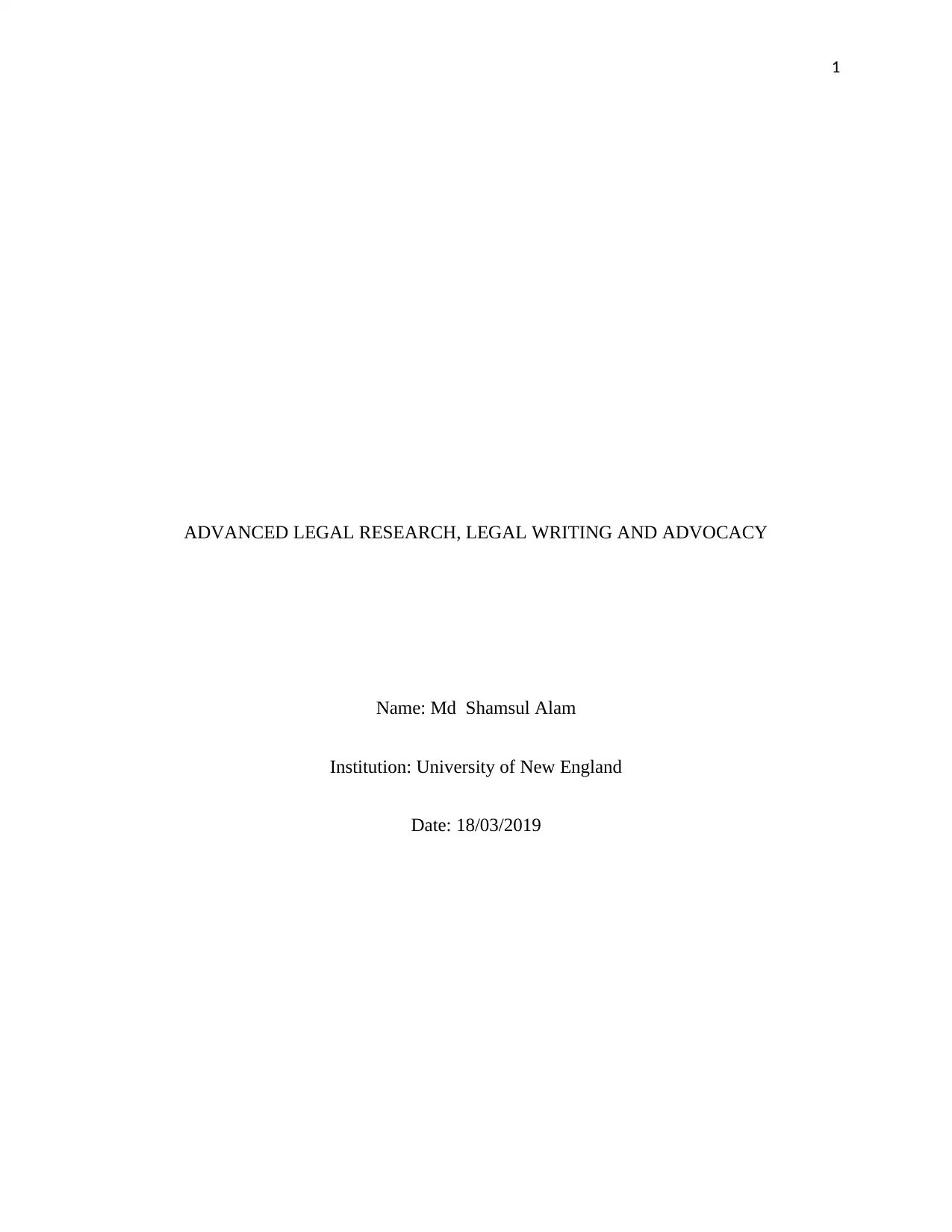
1
ADVANCED LEGAL RESEARCH, LEGAL WRITING AND ADVOCACY
Name: Md Shamsul Alam
Institution: University of New England
Date: 18/03/2019
ADVANCED LEGAL RESEARCH, LEGAL WRITING AND ADVOCACY
Name: Md Shamsul Alam
Institution: University of New England
Date: 18/03/2019
Secure Best Marks with AI Grader
Need help grading? Try our AI Grader for instant feedback on your assignments.
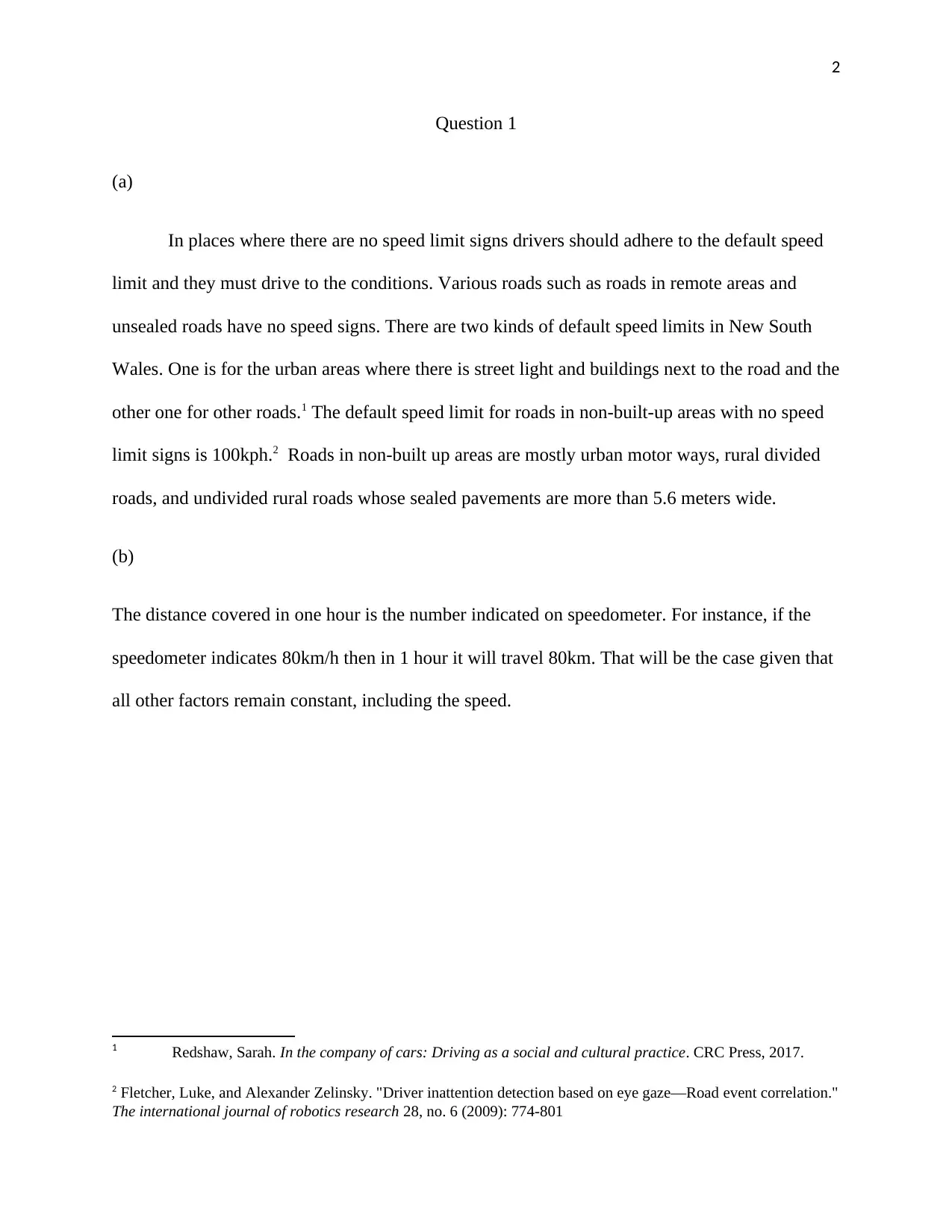
2
Question 1
(a)
In places where there are no speed limit signs drivers should adhere to the default speed
limit and they must drive to the conditions. Various roads such as roads in remote areas and
unsealed roads have no speed signs. There are two kinds of default speed limits in New South
Wales. One is for the urban areas where there is street light and buildings next to the road and the
other one for other roads.1 The default speed limit for roads in non-built-up areas with no speed
limit signs is 100kph.2 Roads in non-built up areas are mostly urban motor ways, rural divided
roads, and undivided rural roads whose sealed pavements are more than 5.6 meters wide.
(b)
The distance covered in one hour is the number indicated on speedometer. For instance, if the
speedometer indicates 80km/h then in 1 hour it will travel 80km. That will be the case given that
all other factors remain constant, including the speed.
1 Redshaw, Sarah. In the company of cars: Driving as a social and cultural practice. CRC Press, 2017.
2 Fletcher, Luke, and Alexander Zelinsky. "Driver inattention detection based on eye gaze—Road event correlation."
The international journal of robotics research 28, no. 6 (2009): 774-801
Question 1
(a)
In places where there are no speed limit signs drivers should adhere to the default speed
limit and they must drive to the conditions. Various roads such as roads in remote areas and
unsealed roads have no speed signs. There are two kinds of default speed limits in New South
Wales. One is for the urban areas where there is street light and buildings next to the road and the
other one for other roads.1 The default speed limit for roads in non-built-up areas with no speed
limit signs is 100kph.2 Roads in non-built up areas are mostly urban motor ways, rural divided
roads, and undivided rural roads whose sealed pavements are more than 5.6 meters wide.
(b)
The distance covered in one hour is the number indicated on speedometer. For instance, if the
speedometer indicates 80km/h then in 1 hour it will travel 80km. That will be the case given that
all other factors remain constant, including the speed.
1 Redshaw, Sarah. In the company of cars: Driving as a social and cultural practice. CRC Press, 2017.
2 Fletcher, Luke, and Alexander Zelinsky. "Driver inattention detection based on eye gaze—Road event correlation."
The international journal of robotics research 28, no. 6 (2009): 774-801
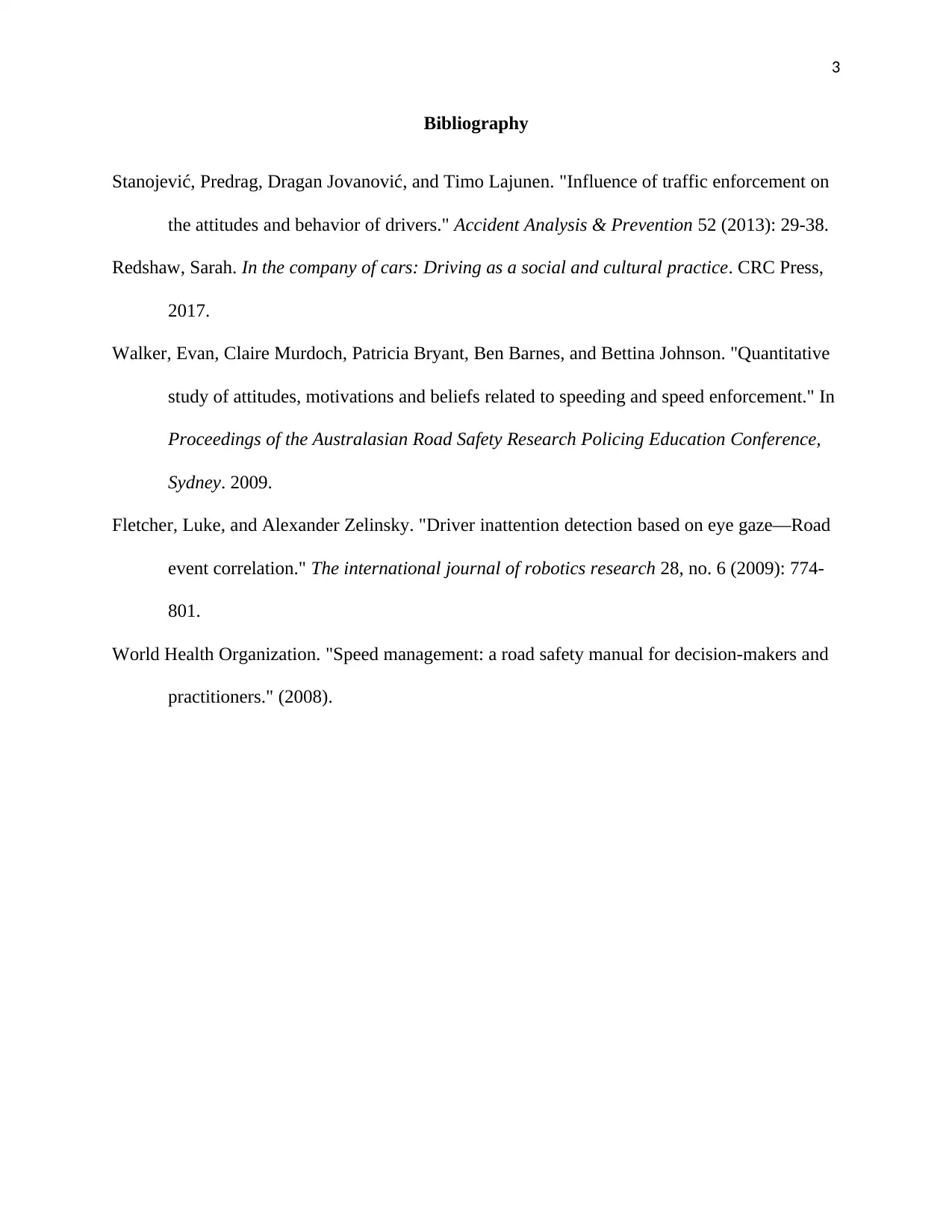
3
Bibliography
Stanojević, Predrag, Dragan Jovanović, and Timo Lajunen. "Influence of traffic enforcement on
the attitudes and behavior of drivers." Accident Analysis & Prevention 52 (2013): 29-38.
Redshaw, Sarah. In the company of cars: Driving as a social and cultural practice. CRC Press,
2017.
Walker, Evan, Claire Murdoch, Patricia Bryant, Ben Barnes, and Bettina Johnson. "Quantitative
study of attitudes, motivations and beliefs related to speeding and speed enforcement." In
Proceedings of the Australasian Road Safety Research Policing Education Conference,
Sydney. 2009.
Fletcher, Luke, and Alexander Zelinsky. "Driver inattention detection based on eye gaze—Road
event correlation." The international journal of robotics research 28, no. 6 (2009): 774-
801.
World Health Organization. "Speed management: a road safety manual for decision-makers and
practitioners." (2008).
Bibliography
Stanojević, Predrag, Dragan Jovanović, and Timo Lajunen. "Influence of traffic enforcement on
the attitudes and behavior of drivers." Accident Analysis & Prevention 52 (2013): 29-38.
Redshaw, Sarah. In the company of cars: Driving as a social and cultural practice. CRC Press,
2017.
Walker, Evan, Claire Murdoch, Patricia Bryant, Ben Barnes, and Bettina Johnson. "Quantitative
study of attitudes, motivations and beliefs related to speeding and speed enforcement." In
Proceedings of the Australasian Road Safety Research Policing Education Conference,
Sydney. 2009.
Fletcher, Luke, and Alexander Zelinsky. "Driver inattention detection based on eye gaze—Road
event correlation." The international journal of robotics research 28, no. 6 (2009): 774-
801.
World Health Organization. "Speed management: a road safety manual for decision-makers and
practitioners." (2008).
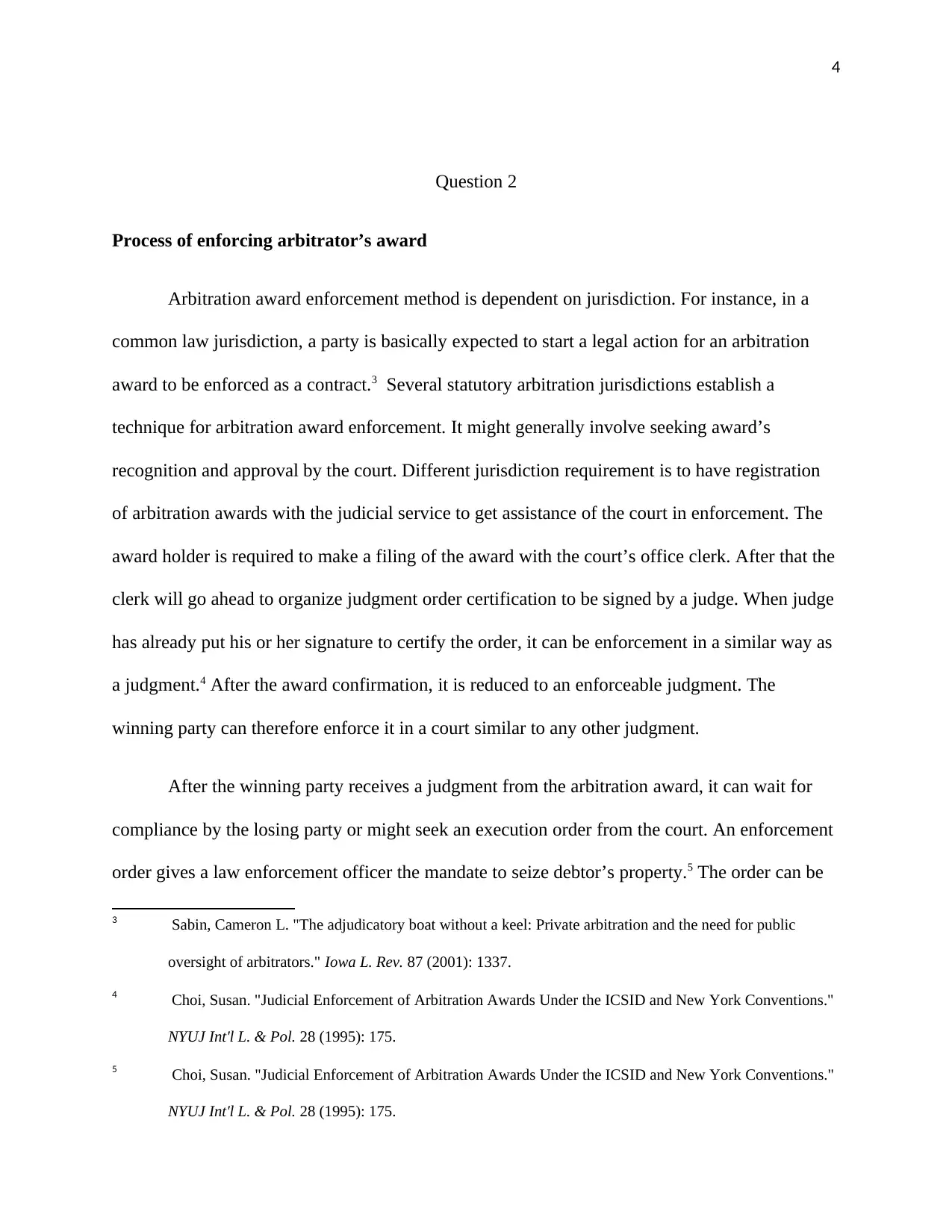
4
Question 2
Process of enforcing arbitrator’s award
Arbitration award enforcement method is dependent on jurisdiction. For instance, in a
common law jurisdiction, a party is basically expected to start a legal action for an arbitration
award to be enforced as a contract.3 Several statutory arbitration jurisdictions establish a
technique for arbitration award enforcement. It might generally involve seeking award’s
recognition and approval by the court. Different jurisdiction requirement is to have registration
of arbitration awards with the judicial service to get assistance of the court in enforcement. The
award holder is required to make a filing of the award with the court’s office clerk. After that the
clerk will go ahead to organize judgment order certification to be signed by a judge. When judge
has already put his or her signature to certify the order, it can be enforcement in a similar way as
a judgment.4 After the award confirmation, it is reduced to an enforceable judgment. The
winning party can therefore enforce it in a court similar to any other judgment.
After the winning party receives a judgment from the arbitration award, it can wait for
compliance by the losing party or might seek an execution order from the court. An enforcement
order gives a law enforcement officer the mandate to seize debtor’s property.5 The order can be
3 Sabin, Cameron L. "The adjudicatory boat without a keel: Private arbitration and the need for public
oversight of arbitrators." Iowa L. Rev. 87 (2001): 1337.
4 Choi, Susan. "Judicial Enforcement of Arbitration Awards Under the ICSID and New York Conventions."
NYUJ Int'l L. & Pol. 28 (1995): 175.
5 Choi, Susan. "Judicial Enforcement of Arbitration Awards Under the ICSID and New York Conventions."
NYUJ Int'l L. & Pol. 28 (1995): 175.
Question 2
Process of enforcing arbitrator’s award
Arbitration award enforcement method is dependent on jurisdiction. For instance, in a
common law jurisdiction, a party is basically expected to start a legal action for an arbitration
award to be enforced as a contract.3 Several statutory arbitration jurisdictions establish a
technique for arbitration award enforcement. It might generally involve seeking award’s
recognition and approval by the court. Different jurisdiction requirement is to have registration
of arbitration awards with the judicial service to get assistance of the court in enforcement. The
award holder is required to make a filing of the award with the court’s office clerk. After that the
clerk will go ahead to organize judgment order certification to be signed by a judge. When judge
has already put his or her signature to certify the order, it can be enforcement in a similar way as
a judgment.4 After the award confirmation, it is reduced to an enforceable judgment. The
winning party can therefore enforce it in a court similar to any other judgment.
After the winning party receives a judgment from the arbitration award, it can wait for
compliance by the losing party or might seek an execution order from the court. An enforcement
order gives a law enforcement officer the mandate to seize debtor’s property.5 The order can be
3 Sabin, Cameron L. "The adjudicatory boat without a keel: Private arbitration and the need for public
oversight of arbitrators." Iowa L. Rev. 87 (2001): 1337.
4 Choi, Susan. "Judicial Enforcement of Arbitration Awards Under the ICSID and New York Conventions."
NYUJ Int'l L. & Pol. 28 (1995): 175.
5 Choi, Susan. "Judicial Enforcement of Arbitration Awards Under the ICSID and New York Conventions."
NYUJ Int'l L. & Pol. 28 (1995): 175.
Secure Best Marks with AI Grader
Need help grading? Try our AI Grader for instant feedback on your assignments.
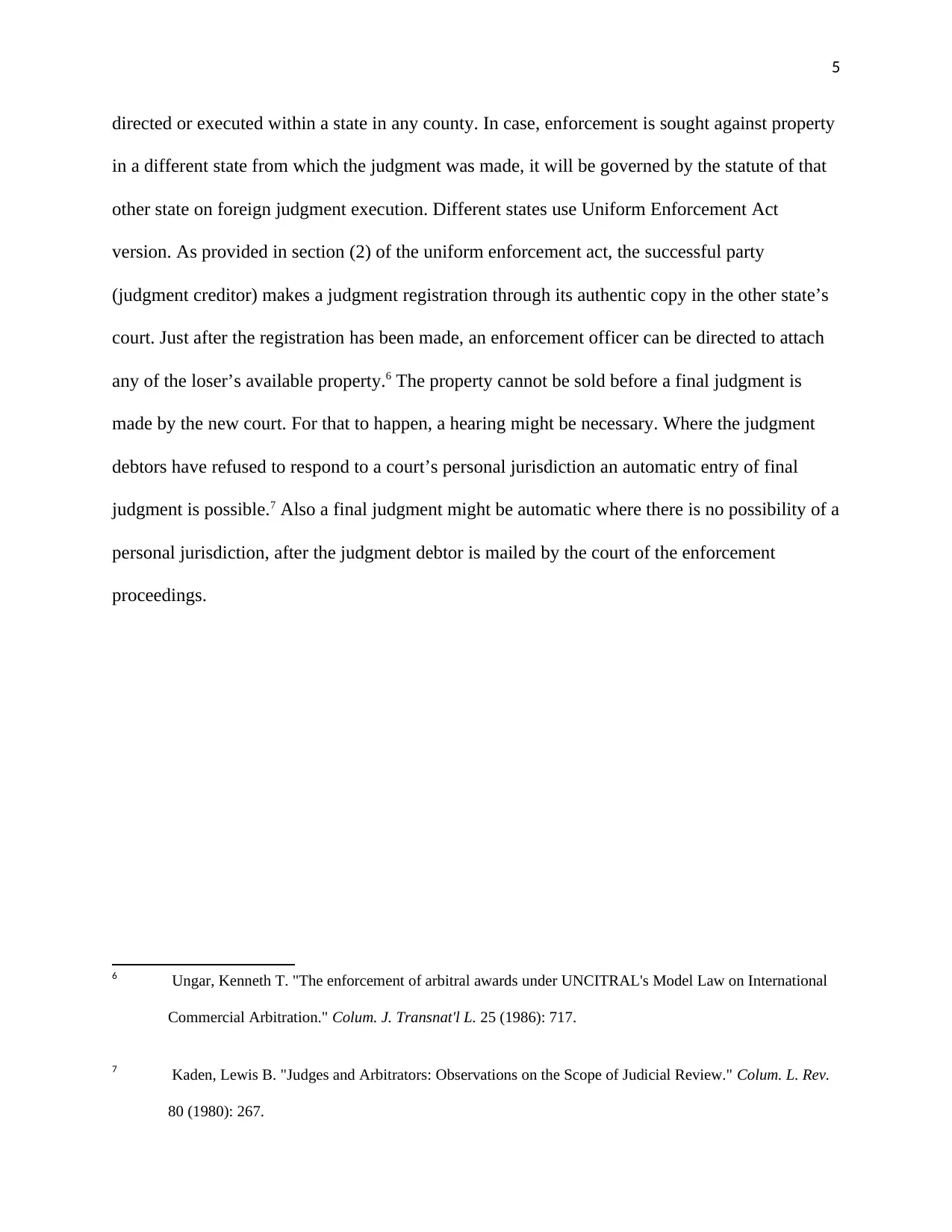
5
directed or executed within a state in any county. In case, enforcement is sought against property
in a different state from which the judgment was made, it will be governed by the statute of that
other state on foreign judgment execution. Different states use Uniform Enforcement Act
version. As provided in section (2) of the uniform enforcement act, the successful party
(judgment creditor) makes a judgment registration through its authentic copy in the other state’s
court. Just after the registration has been made, an enforcement officer can be directed to attach
any of the loser’s available property.6 The property cannot be sold before a final judgment is
made by the new court. For that to happen, a hearing might be necessary. Where the judgment
debtors have refused to respond to a court’s personal jurisdiction an automatic entry of final
judgment is possible.7 Also a final judgment might be automatic where there is no possibility of a
personal jurisdiction, after the judgment debtor is mailed by the court of the enforcement
proceedings.
6 Ungar, Kenneth T. "The enforcement of arbitral awards under UNCITRAL's Model Law on International
Commercial Arbitration." Colum. J. Transnat'l L. 25 (1986): 717.
7 Kaden, Lewis B. "Judges and Arbitrators: Observations on the Scope of Judicial Review." Colum. L. Rev.
80 (1980): 267.
directed or executed within a state in any county. In case, enforcement is sought against property
in a different state from which the judgment was made, it will be governed by the statute of that
other state on foreign judgment execution. Different states use Uniform Enforcement Act
version. As provided in section (2) of the uniform enforcement act, the successful party
(judgment creditor) makes a judgment registration through its authentic copy in the other state’s
court. Just after the registration has been made, an enforcement officer can be directed to attach
any of the loser’s available property.6 The property cannot be sold before a final judgment is
made by the new court. For that to happen, a hearing might be necessary. Where the judgment
debtors have refused to respond to a court’s personal jurisdiction an automatic entry of final
judgment is possible.7 Also a final judgment might be automatic where there is no possibility of a
personal jurisdiction, after the judgment debtor is mailed by the court of the enforcement
proceedings.
6 Ungar, Kenneth T. "The enforcement of arbitral awards under UNCITRAL's Model Law on International
Commercial Arbitration." Colum. J. Transnat'l L. 25 (1986): 717.
7 Kaden, Lewis B. "Judges and Arbitrators: Observations on the Scope of Judicial Review." Colum. L. Rev.
80 (1980): 267.
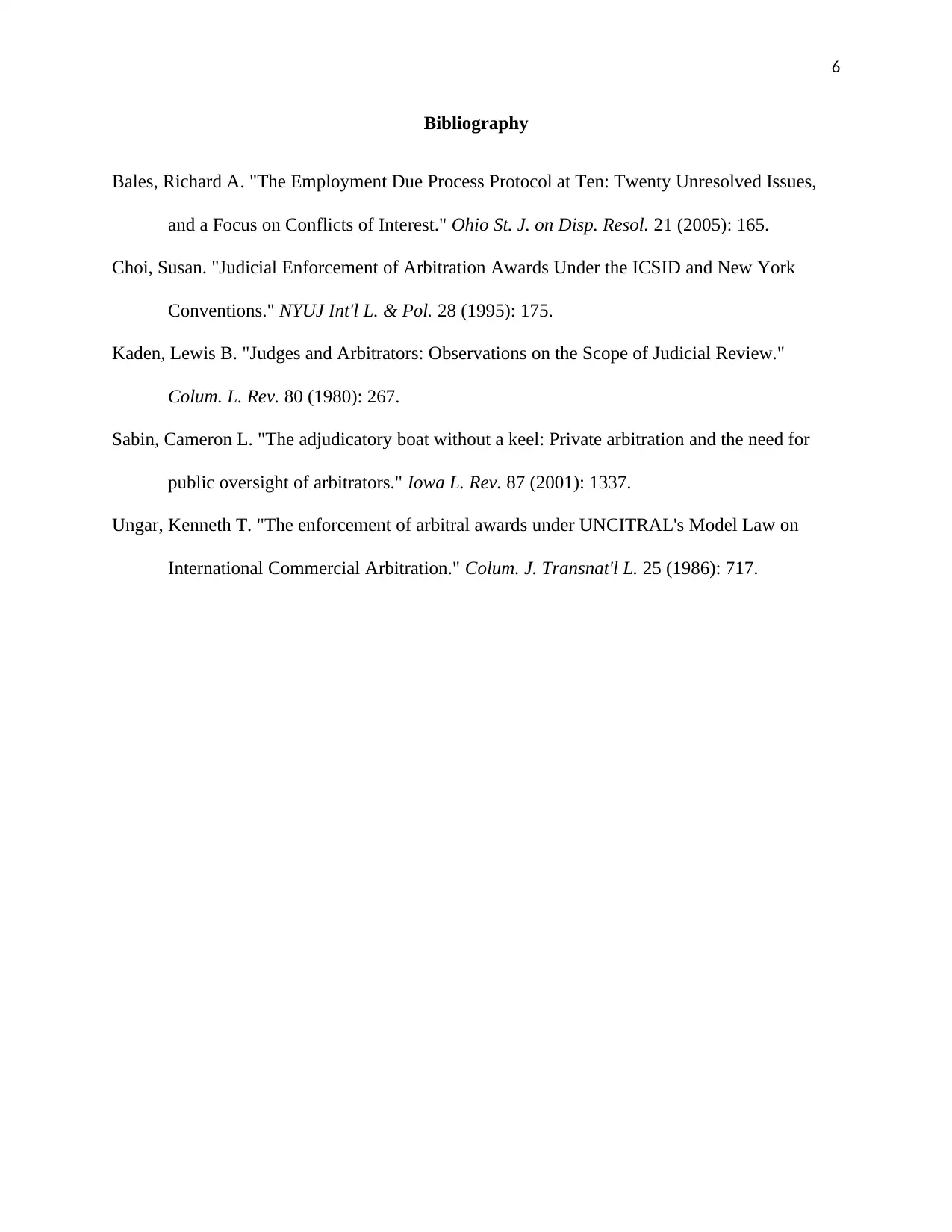
6
Bibliography
Bales, Richard A. "The Employment Due Process Protocol at Ten: Twenty Unresolved Issues,
and a Focus on Conflicts of Interest." Ohio St. J. on Disp. Resol. 21 (2005): 165.
Choi, Susan. "Judicial Enforcement of Arbitration Awards Under the ICSID and New York
Conventions." NYUJ Int'l L. & Pol. 28 (1995): 175.
Kaden, Lewis B. "Judges and Arbitrators: Observations on the Scope of Judicial Review."
Colum. L. Rev. 80 (1980): 267.
Sabin, Cameron L. "The adjudicatory boat without a keel: Private arbitration and the need for
public oversight of arbitrators." Iowa L. Rev. 87 (2001): 1337.
Ungar, Kenneth T. "The enforcement of arbitral awards under UNCITRAL's Model Law on
International Commercial Arbitration." Colum. J. Transnat'l L. 25 (1986): 717.
Bibliography
Bales, Richard A. "The Employment Due Process Protocol at Ten: Twenty Unresolved Issues,
and a Focus on Conflicts of Interest." Ohio St. J. on Disp. Resol. 21 (2005): 165.
Choi, Susan. "Judicial Enforcement of Arbitration Awards Under the ICSID and New York
Conventions." NYUJ Int'l L. & Pol. 28 (1995): 175.
Kaden, Lewis B. "Judges and Arbitrators: Observations on the Scope of Judicial Review."
Colum. L. Rev. 80 (1980): 267.
Sabin, Cameron L. "The adjudicatory boat without a keel: Private arbitration and the need for
public oversight of arbitrators." Iowa L. Rev. 87 (2001): 1337.
Ungar, Kenneth T. "The enforcement of arbitral awards under UNCITRAL's Model Law on
International Commercial Arbitration." Colum. J. Transnat'l L. 25 (1986): 717.
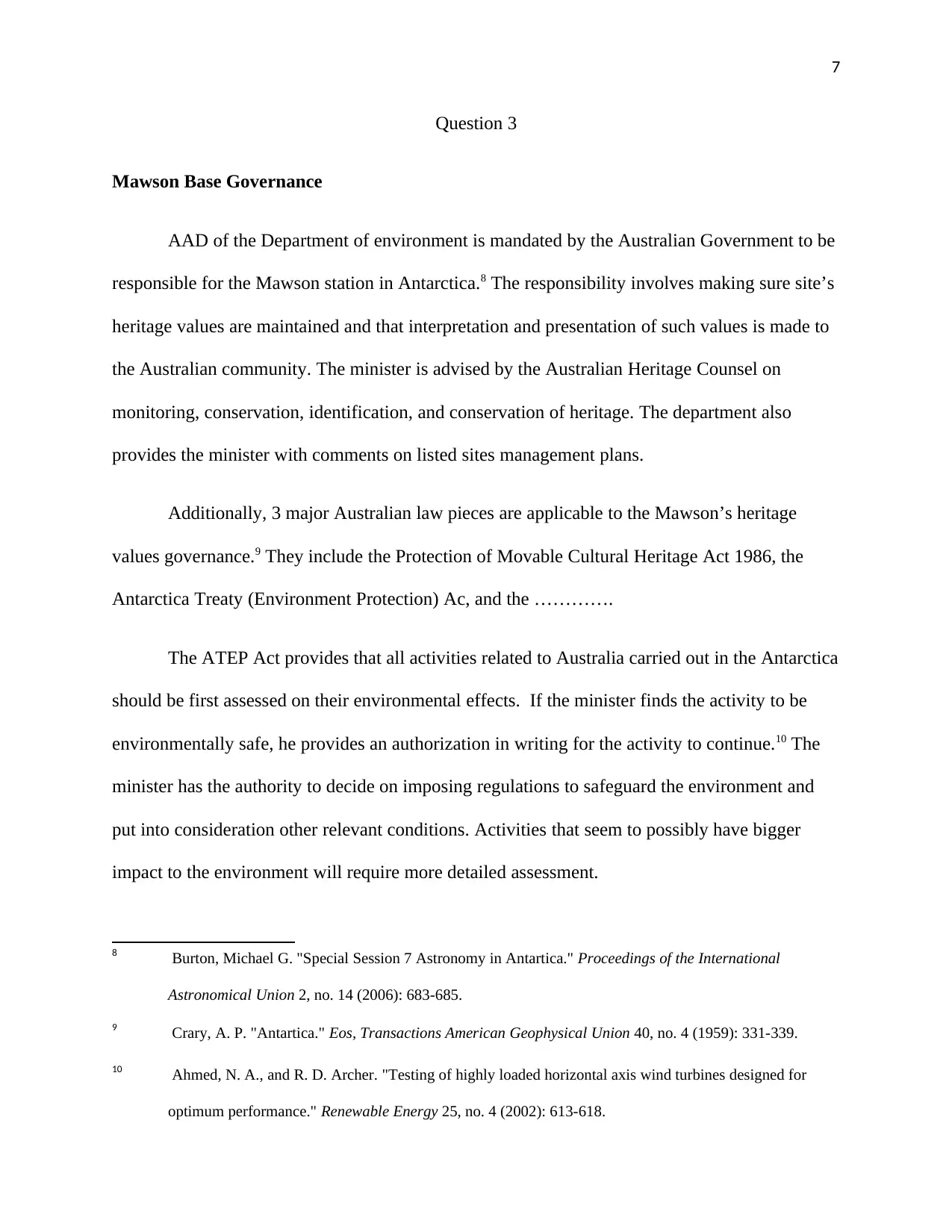
7
Question 3
Mawson Base Governance
AAD of the Department of environment is mandated by the Australian Government to be
responsible for the Mawson station in Antarctica.8 The responsibility involves making sure site’s
heritage values are maintained and that interpretation and presentation of such values is made to
the Australian community. The minister is advised by the Australian Heritage Counsel on
monitoring, conservation, identification, and conservation of heritage. The department also
provides the minister with comments on listed sites management plans.
Additionally, 3 major Australian law pieces are applicable to the Mawson’s heritage
values governance.9 They include the Protection of Movable Cultural Heritage Act 1986, the
Antarctica Treaty (Environment Protection) Ac, and the ………….
The ATEP Act provides that all activities related to Australia carried out in the Antarctica
should be first assessed on their environmental effects. If the minister finds the activity to be
environmentally safe, he provides an authorization in writing for the activity to continue.10 The
minister has the authority to decide on imposing regulations to safeguard the environment and
put into consideration other relevant conditions. Activities that seem to possibly have bigger
impact to the environment will require more detailed assessment.
8 Burton, Michael G. "Special Session 7 Astronomy in Antartica." Proceedings of the International
Astronomical Union 2, no. 14 (2006): 683-685.
9 Crary, A. P. "Antartica." Eos, Transactions American Geophysical Union 40, no. 4 (1959): 331-339.
10 Ahmed, N. A., and R. D. Archer. "Testing of highly loaded horizontal axis wind turbines designed for
optimum performance." Renewable Energy 25, no. 4 (2002): 613-618.
Question 3
Mawson Base Governance
AAD of the Department of environment is mandated by the Australian Government to be
responsible for the Mawson station in Antarctica.8 The responsibility involves making sure site’s
heritage values are maintained and that interpretation and presentation of such values is made to
the Australian community. The minister is advised by the Australian Heritage Counsel on
monitoring, conservation, identification, and conservation of heritage. The department also
provides the minister with comments on listed sites management plans.
Additionally, 3 major Australian law pieces are applicable to the Mawson’s heritage
values governance.9 They include the Protection of Movable Cultural Heritage Act 1986, the
Antarctica Treaty (Environment Protection) Ac, and the ………….
The ATEP Act provides that all activities related to Australia carried out in the Antarctica
should be first assessed on their environmental effects. If the minister finds the activity to be
environmentally safe, he provides an authorization in writing for the activity to continue.10 The
minister has the authority to decide on imposing regulations to safeguard the environment and
put into consideration other relevant conditions. Activities that seem to possibly have bigger
impact to the environment will require more detailed assessment.
8 Burton, Michael G. "Special Session 7 Astronomy in Antartica." Proceedings of the International
Astronomical Union 2, no. 14 (2006): 683-685.
9 Crary, A. P. "Antartica." Eos, Transactions American Geophysical Union 40, no. 4 (1959): 331-339.
10 Ahmed, N. A., and R. D. Archer. "Testing of highly loaded horizontal axis wind turbines designed for
optimum performance." Renewable Energy 25, no. 4 (2002): 613-618.
Paraphrase This Document
Need a fresh take? Get an instant paraphrase of this document with our AI Paraphraser
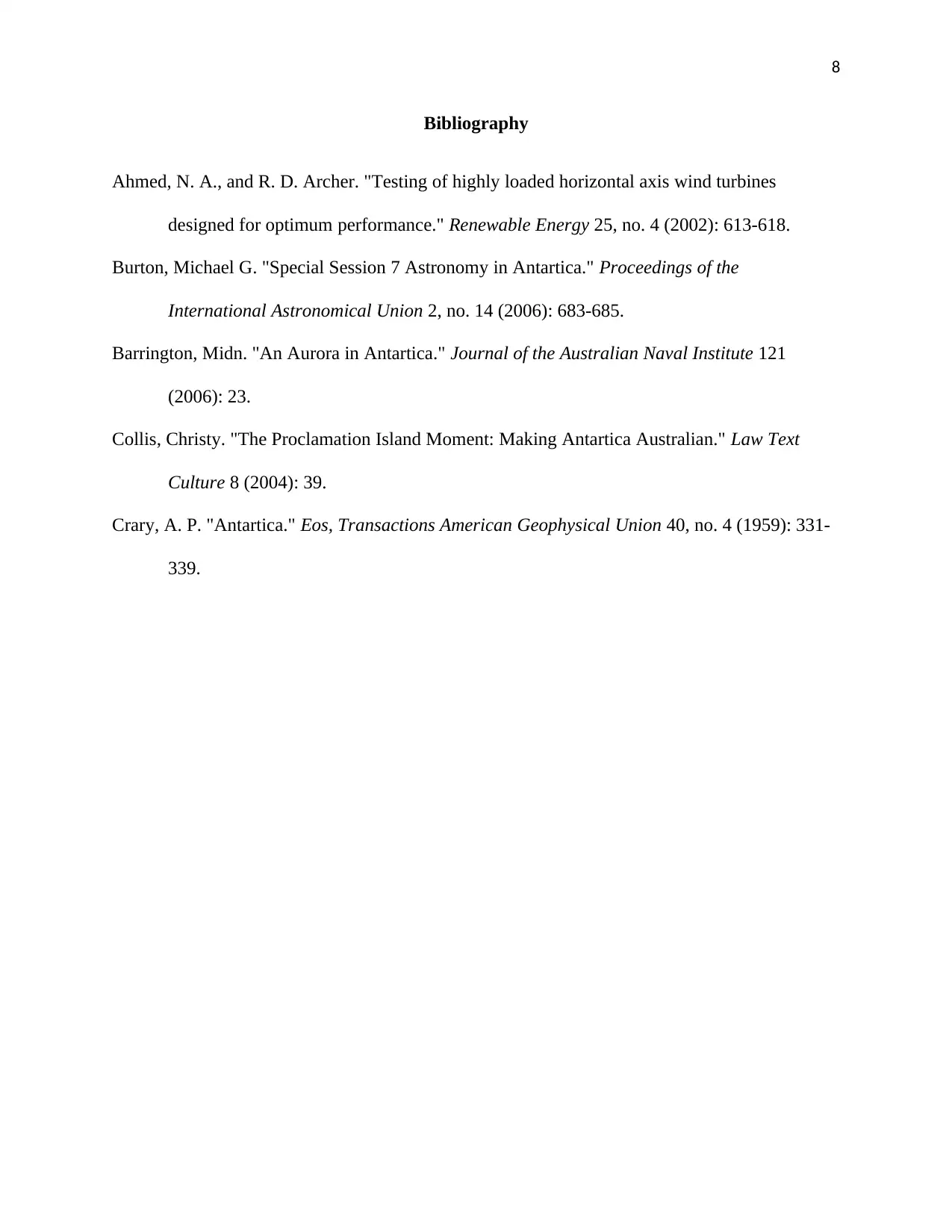
8
Bibliography
Ahmed, N. A., and R. D. Archer. "Testing of highly loaded horizontal axis wind turbines
designed for optimum performance." Renewable Energy 25, no. 4 (2002): 613-618.
Burton, Michael G. "Special Session 7 Astronomy in Antartica." Proceedings of the
International Astronomical Union 2, no. 14 (2006): 683-685.
Barrington, Midn. "An Aurora in Antartica." Journal of the Australian Naval Institute 121
(2006): 23.
Collis, Christy. "The Proclamation Island Moment: Making Antartica Australian." Law Text
Culture 8 (2004): 39.
Crary, A. P. "Antartica." Eos, Transactions American Geophysical Union 40, no. 4 (1959): 331-
339.
Bibliography
Ahmed, N. A., and R. D. Archer. "Testing of highly loaded horizontal axis wind turbines
designed for optimum performance." Renewable Energy 25, no. 4 (2002): 613-618.
Burton, Michael G. "Special Session 7 Astronomy in Antartica." Proceedings of the
International Astronomical Union 2, no. 14 (2006): 683-685.
Barrington, Midn. "An Aurora in Antartica." Journal of the Australian Naval Institute 121
(2006): 23.
Collis, Christy. "The Proclamation Island Moment: Making Antartica Australian." Law Text
Culture 8 (2004): 39.
Crary, A. P. "Antartica." Eos, Transactions American Geophysical Union 40, no. 4 (1959): 331-
339.
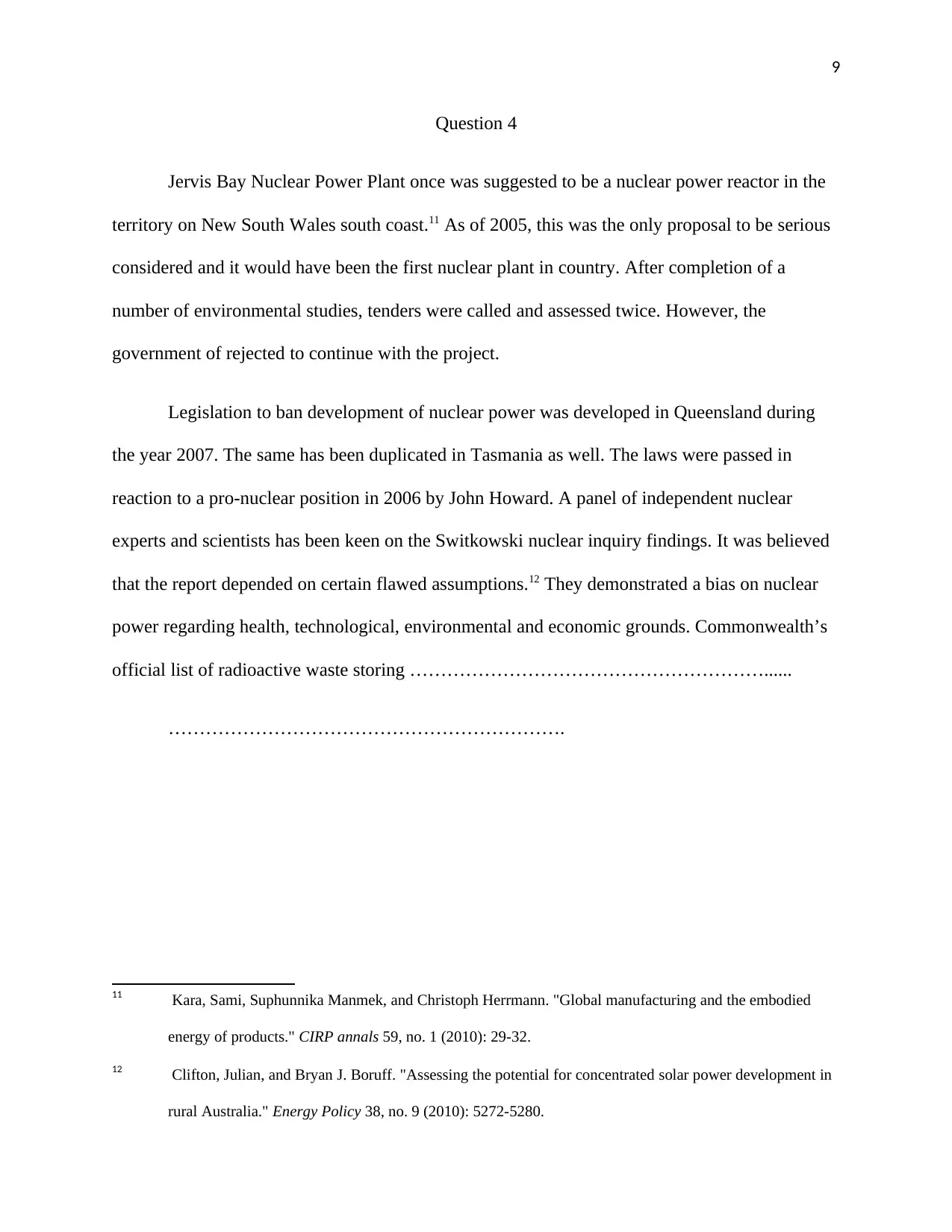
9
Question 4
Jervis Bay Nuclear Power Plant once was suggested to be a nuclear power reactor in the
territory on New South Wales south coast.11 As of 2005, this was the only proposal to be serious
considered and it would have been the first nuclear plant in country. After completion of a
number of environmental studies, tenders were called and assessed twice. However, the
government of rejected to continue with the project.
Legislation to ban development of nuclear power was developed in Queensland during
the year 2007. The same has been duplicated in Tasmania as well. The laws were passed in
reaction to a pro-nuclear position in 2006 by John Howard. A panel of independent nuclear
experts and scientists has been keen on the Switkowski nuclear inquiry findings. It was believed
that the report depended on certain flawed assumptions.12 They demonstrated a bias on nuclear
power regarding health, technological, environmental and economic grounds. Commonwealth’s
official list of radioactive waste storing …………………………………………………......
……………………………………………………….
11 Kara, Sami, Suphunnika Manmek, and Christoph Herrmann. "Global manufacturing and the embodied
energy of products." CIRP annals 59, no. 1 (2010): 29-32.
12 Clifton, Julian, and Bryan J. Boruff. "Assessing the potential for concentrated solar power development in
rural Australia." Energy Policy 38, no. 9 (2010): 5272-5280.
Question 4
Jervis Bay Nuclear Power Plant once was suggested to be a nuclear power reactor in the
territory on New South Wales south coast.11 As of 2005, this was the only proposal to be serious
considered and it would have been the first nuclear plant in country. After completion of a
number of environmental studies, tenders were called and assessed twice. However, the
government of rejected to continue with the project.
Legislation to ban development of nuclear power was developed in Queensland during
the year 2007. The same has been duplicated in Tasmania as well. The laws were passed in
reaction to a pro-nuclear position in 2006 by John Howard. A panel of independent nuclear
experts and scientists has been keen on the Switkowski nuclear inquiry findings. It was believed
that the report depended on certain flawed assumptions.12 They demonstrated a bias on nuclear
power regarding health, technological, environmental and economic grounds. Commonwealth’s
official list of radioactive waste storing …………………………………………………......
……………………………………………………….
11 Kara, Sami, Suphunnika Manmek, and Christoph Herrmann. "Global manufacturing and the embodied
energy of products." CIRP annals 59, no. 1 (2010): 29-32.
12 Clifton, Julian, and Bryan J. Boruff. "Assessing the potential for concentrated solar power development in
rural Australia." Energy Policy 38, no. 9 (2010): 5272-5280.
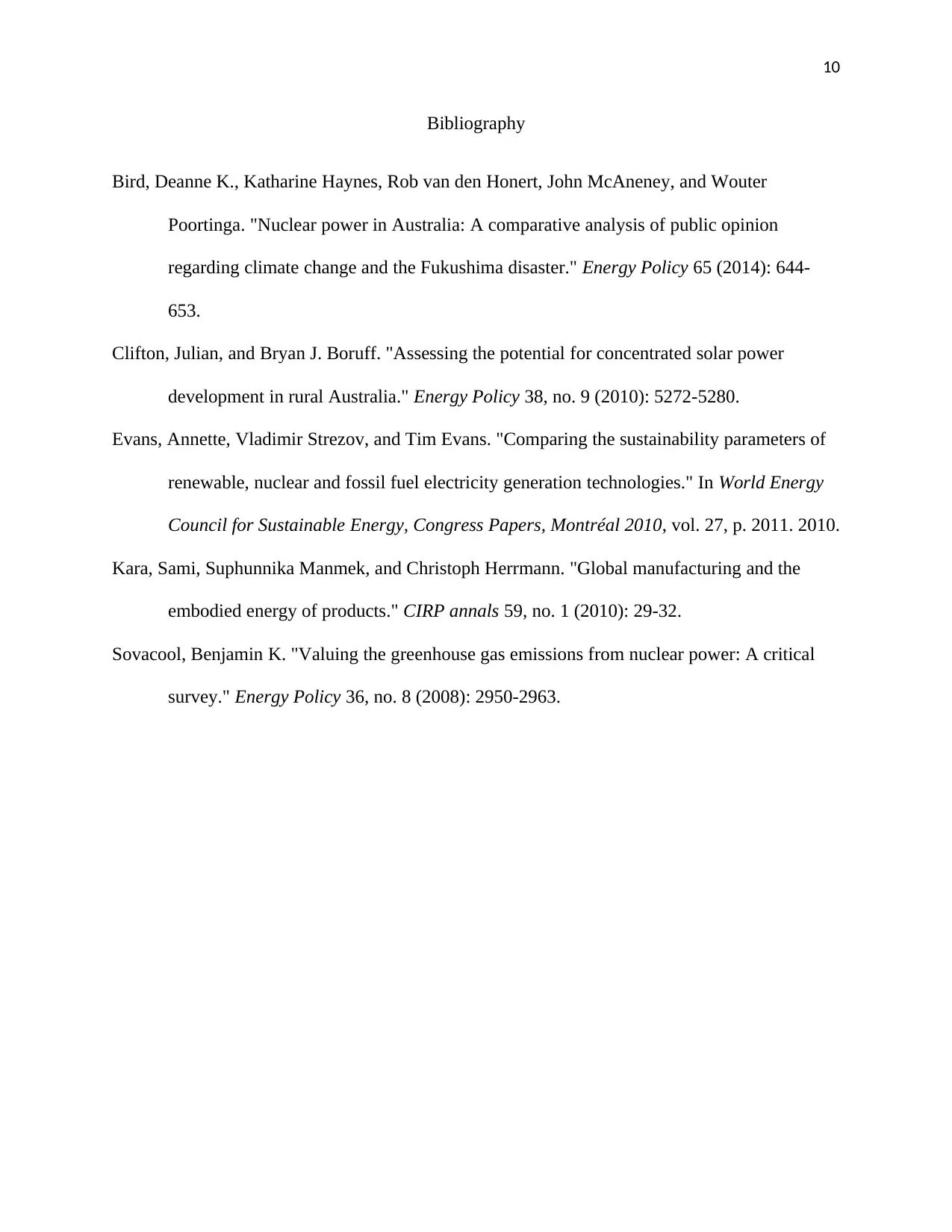
10
Bibliography
Bird, Deanne K., Katharine Haynes, Rob van den Honert, John McAneney, and Wouter
Poortinga. "Nuclear power in Australia: A comparative analysis of public opinion
regarding climate change and the Fukushima disaster." Energy Policy 65 (2014): 644-
653.
Clifton, Julian, and Bryan J. Boruff. "Assessing the potential for concentrated solar power
development in rural Australia." Energy Policy 38, no. 9 (2010): 5272-5280.
Evans, Annette, Vladimir Strezov, and Tim Evans. "Comparing the sustainability parameters of
renewable, nuclear and fossil fuel electricity generation technologies." In World Energy
Council for Sustainable Energy, Congress Papers, Montréal 2010, vol. 27, p. 2011. 2010.
Kara, Sami, Suphunnika Manmek, and Christoph Herrmann. "Global manufacturing and the
embodied energy of products." CIRP annals 59, no. 1 (2010): 29-32.
Sovacool, Benjamin K. "Valuing the greenhouse gas emissions from nuclear power: A critical
survey." Energy Policy 36, no. 8 (2008): 2950-2963.
Bibliography
Bird, Deanne K., Katharine Haynes, Rob van den Honert, John McAneney, and Wouter
Poortinga. "Nuclear power in Australia: A comparative analysis of public opinion
regarding climate change and the Fukushima disaster." Energy Policy 65 (2014): 644-
653.
Clifton, Julian, and Bryan J. Boruff. "Assessing the potential for concentrated solar power
development in rural Australia." Energy Policy 38, no. 9 (2010): 5272-5280.
Evans, Annette, Vladimir Strezov, and Tim Evans. "Comparing the sustainability parameters of
renewable, nuclear and fossil fuel electricity generation technologies." In World Energy
Council for Sustainable Energy, Congress Papers, Montréal 2010, vol. 27, p. 2011. 2010.
Kara, Sami, Suphunnika Manmek, and Christoph Herrmann. "Global manufacturing and the
embodied energy of products." CIRP annals 59, no. 1 (2010): 29-32.
Sovacool, Benjamin K. "Valuing the greenhouse gas emissions from nuclear power: A critical
survey." Energy Policy 36, no. 8 (2008): 2950-2963.
Secure Best Marks with AI Grader
Need help grading? Try our AI Grader for instant feedback on your assignments.
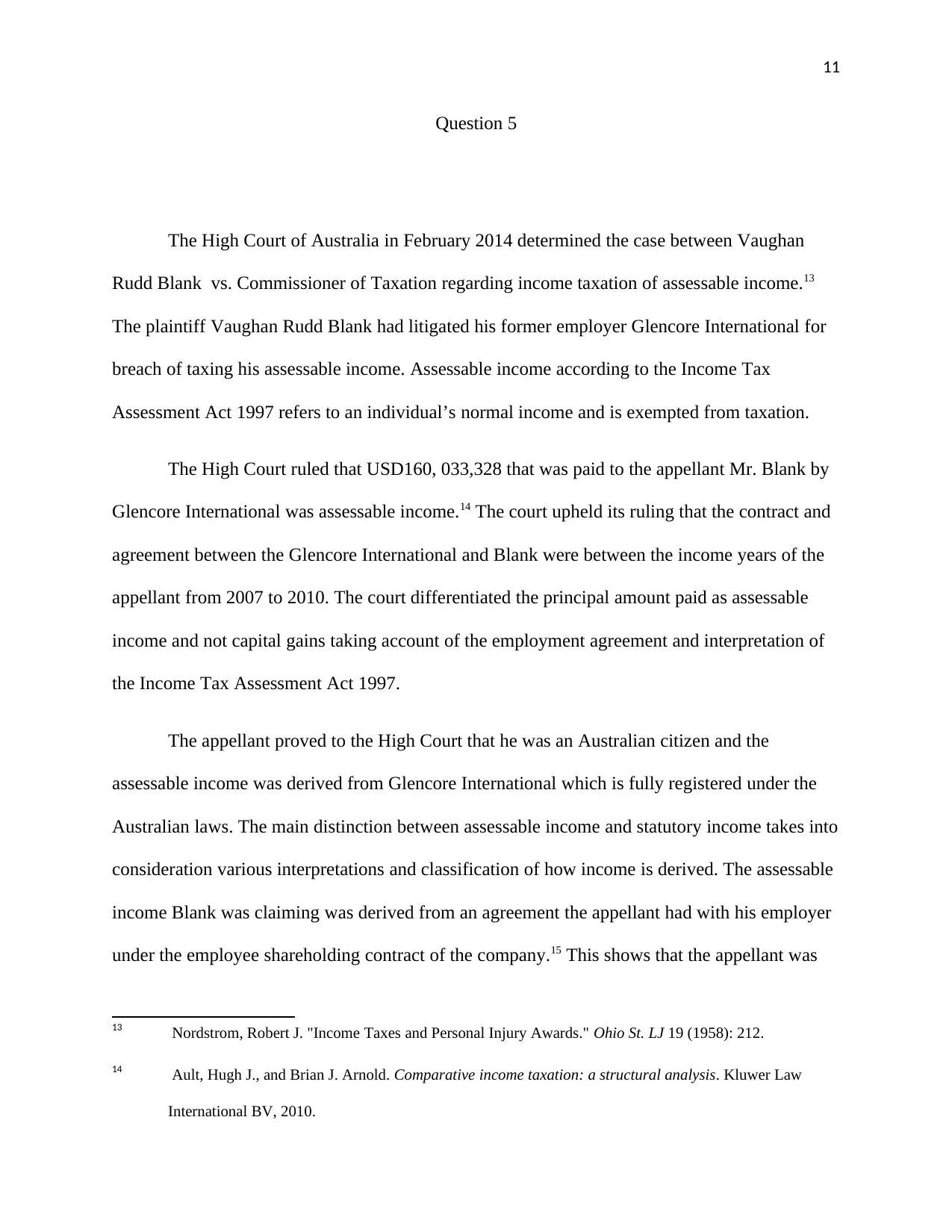
11
Question 5
The High Court of Australia in February 2014 determined the case between Vaughan
Rudd Blank vs. Commissioner of Taxation regarding income taxation of assessable income.13
The plaintiff Vaughan Rudd Blank had litigated his former employer Glencore International for
breach of taxing his assessable income. Assessable income according to the Income Tax
Assessment Act 1997 refers to an individual’s normal income and is exempted from taxation.
The High Court ruled that USD160, 033,328 that was paid to the appellant Mr. Blank by
Glencore International was assessable income.14 The court upheld its ruling that the contract and
agreement between the Glencore International and Blank were between the income years of the
appellant from 2007 to 2010. The court differentiated the principal amount paid as assessable
income and not capital gains taking account of the employment agreement and interpretation of
the Income Tax Assessment Act 1997.
The appellant proved to the High Court that he was an Australian citizen and the
assessable income was derived from Glencore International which is fully registered under the
Australian laws. The main distinction between assessable income and statutory income takes into
consideration various interpretations and classification of how income is derived. The assessable
income Blank was claiming was derived from an agreement the appellant had with his employer
under the employee shareholding contract of the company.15 This shows that the appellant was
13 Nordstrom, Robert J. "Income Taxes and Personal Injury Awards." Ohio St. LJ 19 (1958): 212.
14 Ault, Hugh J., and Brian J. Arnold. Comparative income taxation: a structural analysis. Kluwer Law
International BV, 2010.
Question 5
The High Court of Australia in February 2014 determined the case between Vaughan
Rudd Blank vs. Commissioner of Taxation regarding income taxation of assessable income.13
The plaintiff Vaughan Rudd Blank had litigated his former employer Glencore International for
breach of taxing his assessable income. Assessable income according to the Income Tax
Assessment Act 1997 refers to an individual’s normal income and is exempted from taxation.
The High Court ruled that USD160, 033,328 that was paid to the appellant Mr. Blank by
Glencore International was assessable income.14 The court upheld its ruling that the contract and
agreement between the Glencore International and Blank were between the income years of the
appellant from 2007 to 2010. The court differentiated the principal amount paid as assessable
income and not capital gains taking account of the employment agreement and interpretation of
the Income Tax Assessment Act 1997.
The appellant proved to the High Court that he was an Australian citizen and the
assessable income was derived from Glencore International which is fully registered under the
Australian laws. The main distinction between assessable income and statutory income takes into
consideration various interpretations and classification of how income is derived. The assessable
income Blank was claiming was derived from an agreement the appellant had with his employer
under the employee shareholding contract of the company.15 This shows that the appellant was
13 Nordstrom, Robert J. "Income Taxes and Personal Injury Awards." Ohio St. LJ 19 (1958): 212.
14 Ault, Hugh J., and Brian J. Arnold. Comparative income taxation: a structural analysis. Kluwer Law
International BV, 2010.

12
not carrying out his business or employment to benefit from capital gains tax exemption but he
was legally entitled to the assessable income.
15 Rudick, Harry J. "Dividends and Earnings or Profits Under the Income Tax Law: Corporate
Nonliquidating Distributions." U. Pa. L. Rev. 89 (2010): 865.
not carrying out his business or employment to benefit from capital gains tax exemption but he
was legally entitled to the assessable income.
15 Rudick, Harry J. "Dividends and Earnings or Profits Under the Income Tax Law: Corporate
Nonliquidating Distributions." U. Pa. L. Rev. 89 (2010): 865.
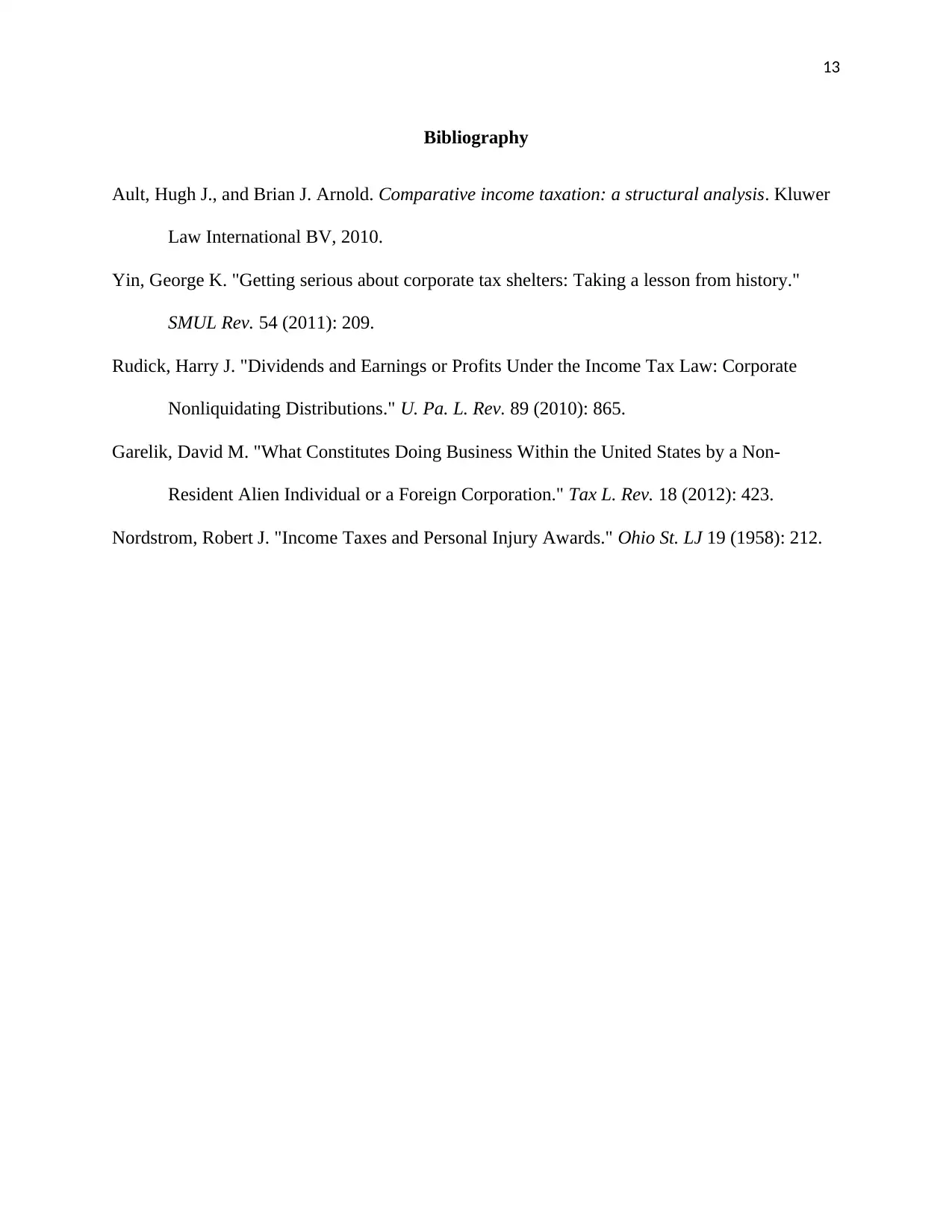
13
Bibliography
Ault, Hugh J., and Brian J. Arnold. Comparative income taxation: a structural analysis. Kluwer
Law International BV, 2010.
Yin, George K. "Getting serious about corporate tax shelters: Taking a lesson from history."
SMUL Rev. 54 (2011): 209.
Rudick, Harry J. "Dividends and Earnings or Profits Under the Income Tax Law: Corporate
Nonliquidating Distributions." U. Pa. L. Rev. 89 (2010): 865.
Garelik, David M. "What Constitutes Doing Business Within the United States by a Non-
Resident Alien Individual or a Foreign Corporation." Tax L. Rev. 18 (2012): 423.
Nordstrom, Robert J. "Income Taxes and Personal Injury Awards." Ohio St. LJ 19 (1958): 212.
Bibliography
Ault, Hugh J., and Brian J. Arnold. Comparative income taxation: a structural analysis. Kluwer
Law International BV, 2010.
Yin, George K. "Getting serious about corporate tax shelters: Taking a lesson from history."
SMUL Rev. 54 (2011): 209.
Rudick, Harry J. "Dividends and Earnings or Profits Under the Income Tax Law: Corporate
Nonliquidating Distributions." U. Pa. L. Rev. 89 (2010): 865.
Garelik, David M. "What Constitutes Doing Business Within the United States by a Non-
Resident Alien Individual or a Foreign Corporation." Tax L. Rev. 18 (2012): 423.
Nordstrom, Robert J. "Income Taxes and Personal Injury Awards." Ohio St. LJ 19 (1958): 212.
Paraphrase This Document
Need a fresh take? Get an instant paraphrase of this document with our AI Paraphraser
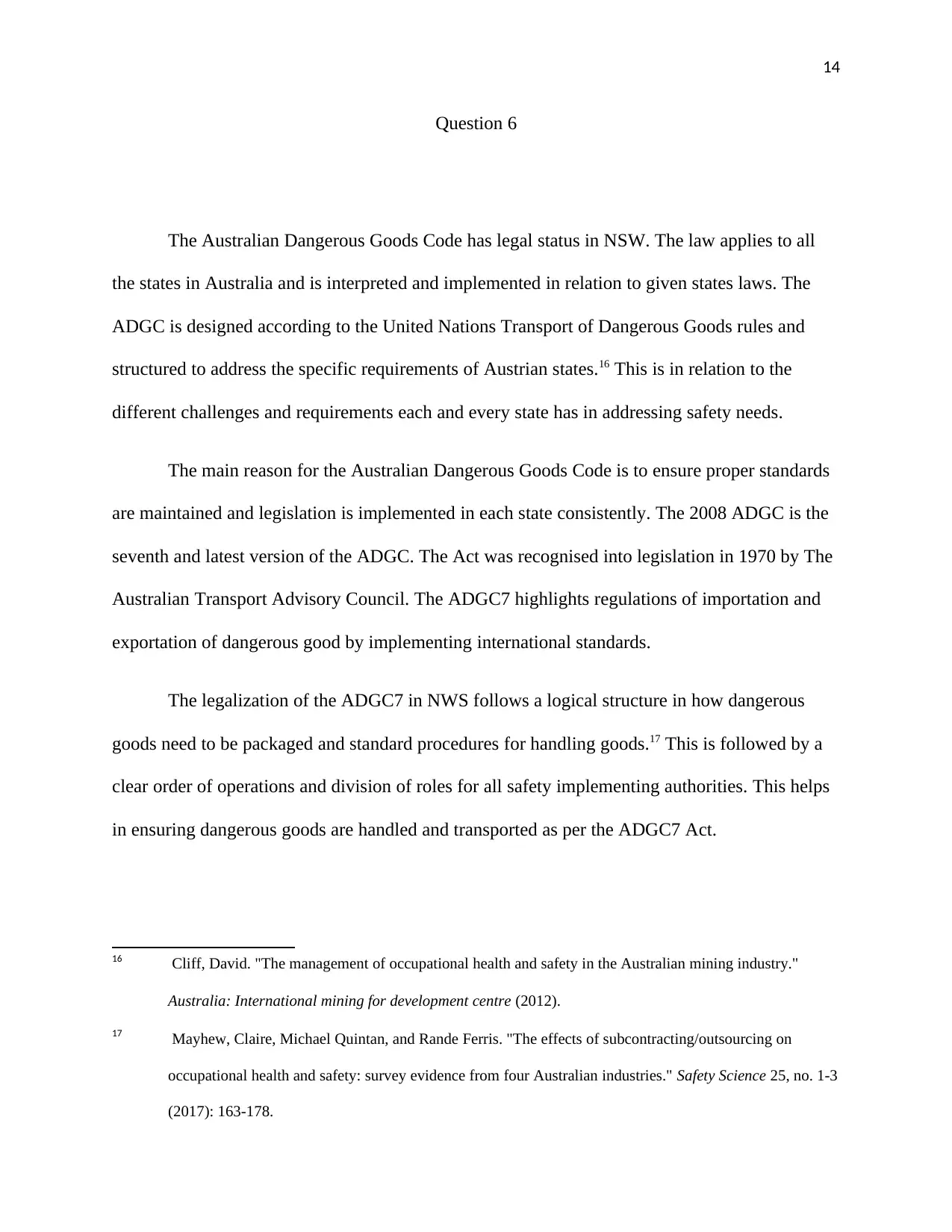
14
Question 6
The Australian Dangerous Goods Code has legal status in NSW. The law applies to all
the states in Australia and is interpreted and implemented in relation to given states laws. The
ADGC is designed according to the United Nations Transport of Dangerous Goods rules and
structured to address the specific requirements of Austrian states.16 This is in relation to the
different challenges and requirements each and every state has in addressing safety needs.
The main reason for the Australian Dangerous Goods Code is to ensure proper standards
are maintained and legislation is implemented in each state consistently. The 2008 ADGC is the
seventh and latest version of the ADGC. The Act was recognised into legislation in 1970 by The
Australian Transport Advisory Council. The ADGC7 highlights regulations of importation and
exportation of dangerous good by implementing international standards.
The legalization of the ADGC7 in NWS follows a logical structure in how dangerous
goods need to be packaged and standard procedures for handling goods.17 This is followed by a
clear order of operations and division of roles for all safety implementing authorities. This helps
in ensuring dangerous goods are handled and transported as per the ADGC7 Act.
16 Cliff, David. "The management of occupational health and safety in the Australian mining industry."
Australia: International mining for development centre (2012).
17 Mayhew, Claire, Michael Quintan, and Rande Ferris. "The effects of subcontracting/outsourcing on
occupational health and safety: survey evidence from four Australian industries." Safety Science 25, no. 1-3
(2017): 163-178.
Question 6
The Australian Dangerous Goods Code has legal status in NSW. The law applies to all
the states in Australia and is interpreted and implemented in relation to given states laws. The
ADGC is designed according to the United Nations Transport of Dangerous Goods rules and
structured to address the specific requirements of Austrian states.16 This is in relation to the
different challenges and requirements each and every state has in addressing safety needs.
The main reason for the Australian Dangerous Goods Code is to ensure proper standards
are maintained and legislation is implemented in each state consistently. The 2008 ADGC is the
seventh and latest version of the ADGC. The Act was recognised into legislation in 1970 by The
Australian Transport Advisory Council. The ADGC7 highlights regulations of importation and
exportation of dangerous good by implementing international standards.
The legalization of the ADGC7 in NWS follows a logical structure in how dangerous
goods need to be packaged and standard procedures for handling goods.17 This is followed by a
clear order of operations and division of roles for all safety implementing authorities. This helps
in ensuring dangerous goods are handled and transported as per the ADGC7 Act.
16 Cliff, David. "The management of occupational health and safety in the Australian mining industry."
Australia: International mining for development centre (2012).
17 Mayhew, Claire, Michael Quintan, and Rande Ferris. "The effects of subcontracting/outsourcing on
occupational health and safety: survey evidence from four Australian industries." Safety Science 25, no. 1-3
(2017): 163-178.
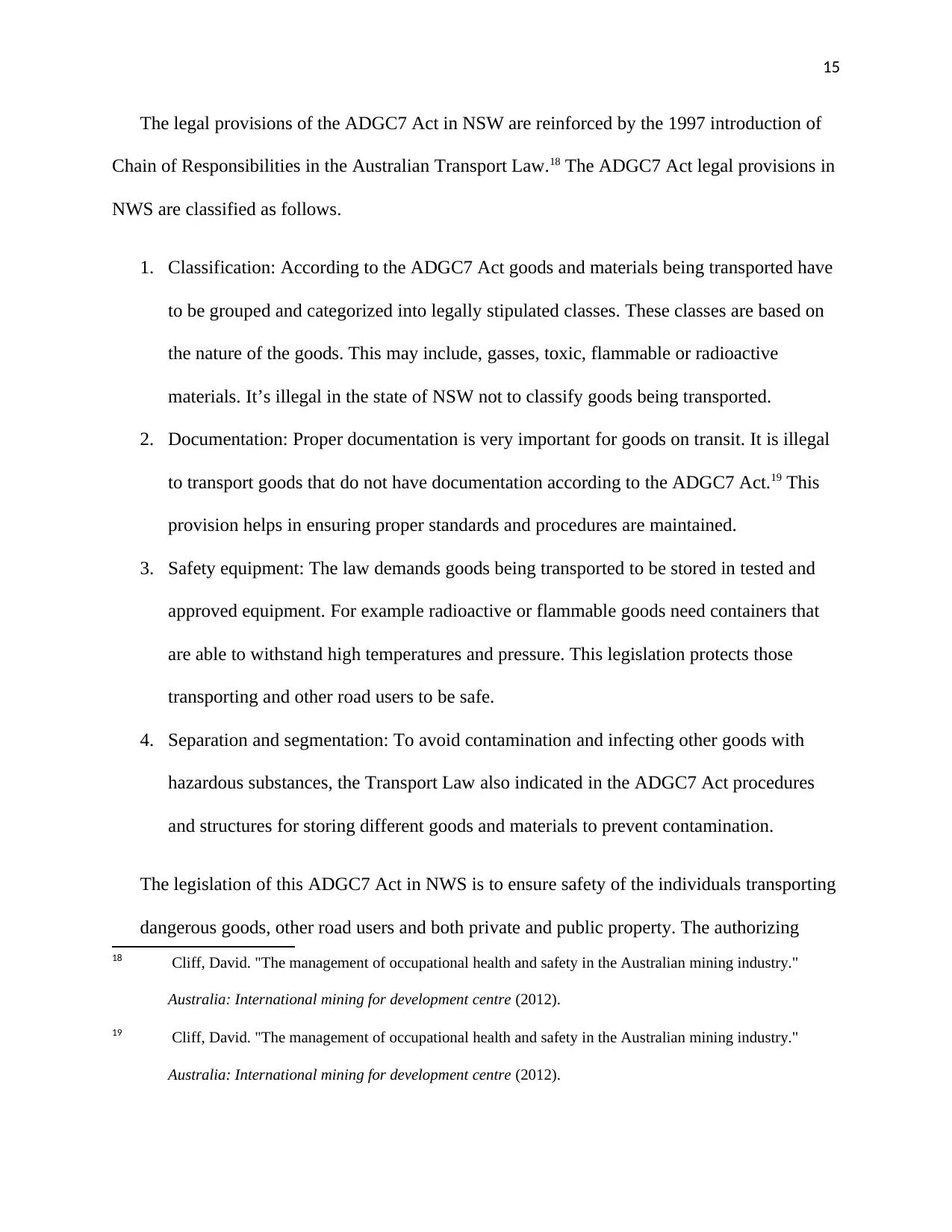
15
The legal provisions of the ADGC7 Act in NSW are reinforced by the 1997 introduction of
Chain of Responsibilities in the Australian Transport Law.18 The ADGC7 Act legal provisions in
NWS are classified as follows.
1. Classification: According to the ADGC7 Act goods and materials being transported have
to be grouped and categorized into legally stipulated classes. These classes are based on
the nature of the goods. This may include, gasses, toxic, flammable or radioactive
materials. It’s illegal in the state of NSW not to classify goods being transported.
2. Documentation: Proper documentation is very important for goods on transit. It is illegal
to transport goods that do not have documentation according to the ADGC7 Act.19 This
provision helps in ensuring proper standards and procedures are maintained.
3. Safety equipment: The law demands goods being transported to be stored in tested and
approved equipment. For example radioactive or flammable goods need containers that
are able to withstand high temperatures and pressure. This legislation protects those
transporting and other road users to be safe.
4. Separation and segmentation: To avoid contamination and infecting other goods with
hazardous substances, the Transport Law also indicated in the ADGC7 Act procedures
and structures for storing different goods and materials to prevent contamination.
The legislation of this ADGC7 Act in NWS is to ensure safety of the individuals transporting
dangerous goods, other road users and both private and public property. The authorizing
18 Cliff, David. "The management of occupational health and safety in the Australian mining industry."
Australia: International mining for development centre (2012).
19 Cliff, David. "The management of occupational health and safety in the Australian mining industry."
Australia: International mining for development centre (2012).
The legal provisions of the ADGC7 Act in NSW are reinforced by the 1997 introduction of
Chain of Responsibilities in the Australian Transport Law.18 The ADGC7 Act legal provisions in
NWS are classified as follows.
1. Classification: According to the ADGC7 Act goods and materials being transported have
to be grouped and categorized into legally stipulated classes. These classes are based on
the nature of the goods. This may include, gasses, toxic, flammable or radioactive
materials. It’s illegal in the state of NSW not to classify goods being transported.
2. Documentation: Proper documentation is very important for goods on transit. It is illegal
to transport goods that do not have documentation according to the ADGC7 Act.19 This
provision helps in ensuring proper standards and procedures are maintained.
3. Safety equipment: The law demands goods being transported to be stored in tested and
approved equipment. For example radioactive or flammable goods need containers that
are able to withstand high temperatures and pressure. This legislation protects those
transporting and other road users to be safe.
4. Separation and segmentation: To avoid contamination and infecting other goods with
hazardous substances, the Transport Law also indicated in the ADGC7 Act procedures
and structures for storing different goods and materials to prevent contamination.
The legislation of this ADGC7 Act in NWS is to ensure safety of the individuals transporting
dangerous goods, other road users and both private and public property. The authorizing
18 Cliff, David. "The management of occupational health and safety in the Australian mining industry."
Australia: International mining for development centre (2012).
19 Cliff, David. "The management of occupational health and safety in the Australian mining industry."
Australia: International mining for development centre (2012).

16
persons in NWS according to the law are individuals appointed under section 17 of the Act or
a police officer. The ADGC7 Act has legal status in NWS which is a state within Australia.
The ADGC7 Act also applies to countries under the common wealth law and regulated by the
United Nations Transport and Regulations Act.
persons in NWS according to the law are individuals appointed under section 17 of the Act or
a police officer. The ADGC7 Act has legal status in NWS which is a state within Australia.
The ADGC7 Act also applies to countries under the common wealth law and regulated by the
United Nations Transport and Regulations Act.
Secure Best Marks with AI Grader
Need help grading? Try our AI Grader for instant feedback on your assignments.
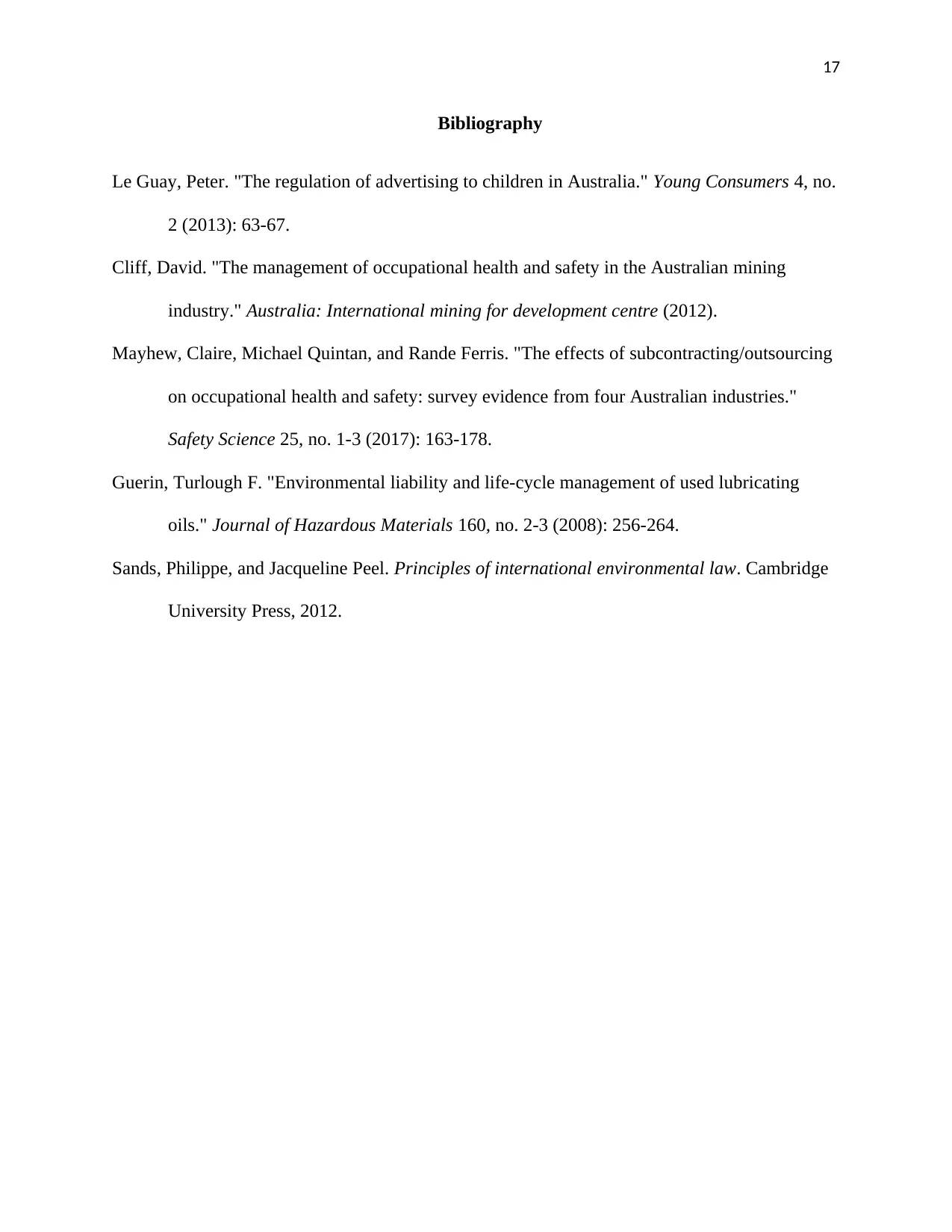
17
Bibliography
Le Guay, Peter. "The regulation of advertising to children in Australia." Young Consumers 4, no.
2 (2013): 63-67.
Cliff, David. "The management of occupational health and safety in the Australian mining
industry." Australia: International mining for development centre (2012).
Mayhew, Claire, Michael Quintan, and Rande Ferris. "The effects of subcontracting/outsourcing
on occupational health and safety: survey evidence from four Australian industries."
Safety Science 25, no. 1-3 (2017): 163-178.
Guerin, Turlough F. "Environmental liability and life-cycle management of used lubricating
oils." Journal of Hazardous Materials 160, no. 2-3 (2008): 256-264.
Sands, Philippe, and Jacqueline Peel. Principles of international environmental law. Cambridge
University Press, 2012.
Bibliography
Le Guay, Peter. "The regulation of advertising to children in Australia." Young Consumers 4, no.
2 (2013): 63-67.
Cliff, David. "The management of occupational health and safety in the Australian mining
industry." Australia: International mining for development centre (2012).
Mayhew, Claire, Michael Quintan, and Rande Ferris. "The effects of subcontracting/outsourcing
on occupational health and safety: survey evidence from four Australian industries."
Safety Science 25, no. 1-3 (2017): 163-178.
Guerin, Turlough F. "Environmental liability and life-cycle management of used lubricating
oils." Journal of Hazardous Materials 160, no. 2-3 (2008): 256-264.
Sands, Philippe, and Jacqueline Peel. Principles of international environmental law. Cambridge
University Press, 2012.
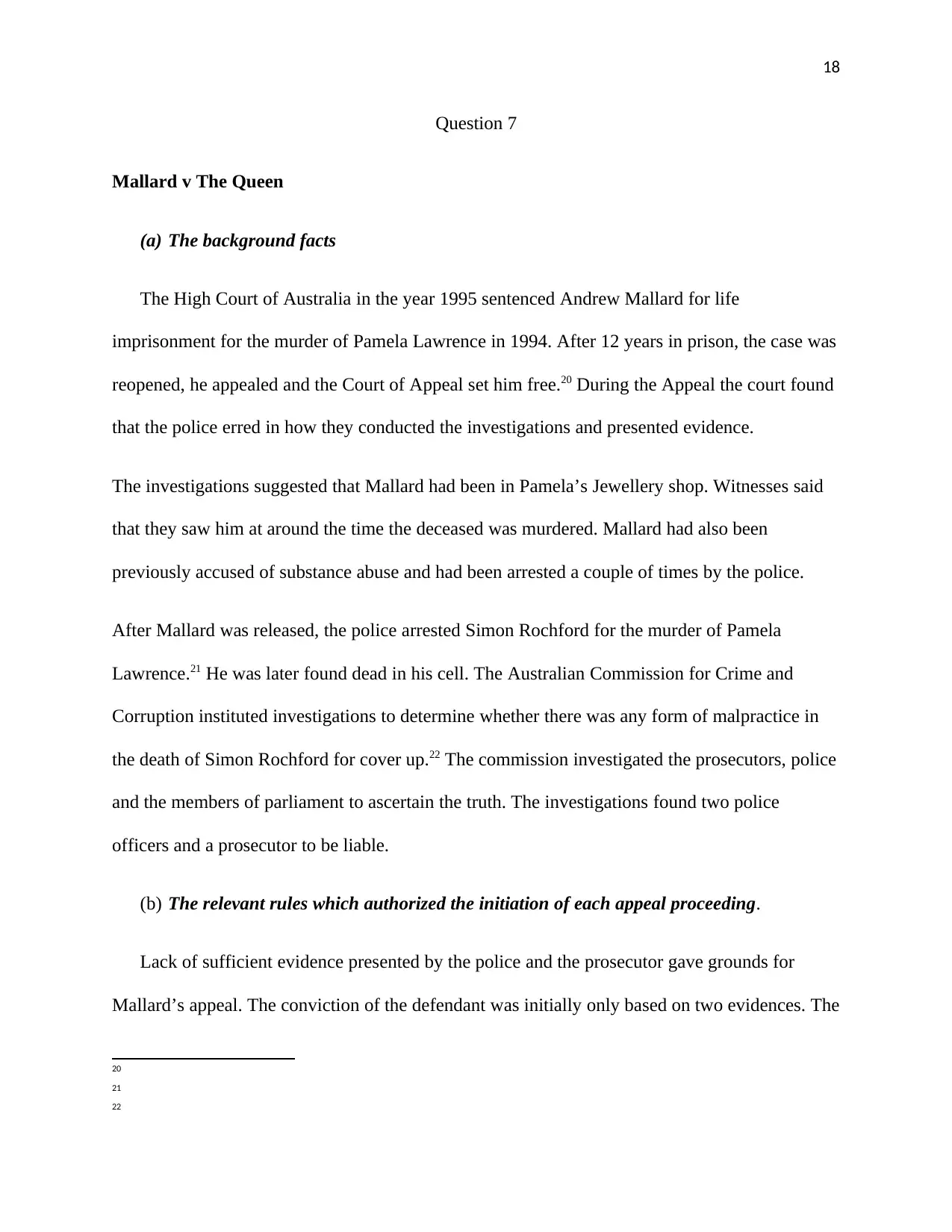
18
Question 7
Mallard v The Queen
(a) The background facts
The High Court of Australia in the year 1995 sentenced Andrew Mallard for life
imprisonment for the murder of Pamela Lawrence in 1994. After 12 years in prison, the case was
reopened, he appealed and the Court of Appeal set him free.20 During the Appeal the court found
that the police erred in how they conducted the investigations and presented evidence.
The investigations suggested that Mallard had been in Pamela’s Jewellery shop. Witnesses said
that they saw him at around the time the deceased was murdered. Mallard had also been
previously accused of substance abuse and had been arrested a couple of times by the police.
After Mallard was released, the police arrested Simon Rochford for the murder of Pamela
Lawrence.21 He was later found dead in his cell. The Australian Commission for Crime and
Corruption instituted investigations to determine whether there was any form of malpractice in
the death of Simon Rochford for cover up.22 The commission investigated the prosecutors, police
and the members of parliament to ascertain the truth. The investigations found two police
officers and a prosecutor to be liable.
(b) The relevant rules which authorized the initiation of each appeal proceeding.
Lack of sufficient evidence presented by the police and the prosecutor gave grounds for
Mallard’s appeal. The conviction of the defendant was initially only based on two evidences. The
20
21
22
Question 7
Mallard v The Queen
(a) The background facts
The High Court of Australia in the year 1995 sentenced Andrew Mallard for life
imprisonment for the murder of Pamela Lawrence in 1994. After 12 years in prison, the case was
reopened, he appealed and the Court of Appeal set him free.20 During the Appeal the court found
that the police erred in how they conducted the investigations and presented evidence.
The investigations suggested that Mallard had been in Pamela’s Jewellery shop. Witnesses said
that they saw him at around the time the deceased was murdered. Mallard had also been
previously accused of substance abuse and had been arrested a couple of times by the police.
After Mallard was released, the police arrested Simon Rochford for the murder of Pamela
Lawrence.21 He was later found dead in his cell. The Australian Commission for Crime and
Corruption instituted investigations to determine whether there was any form of malpractice in
the death of Simon Rochford for cover up.22 The commission investigated the prosecutors, police
and the members of parliament to ascertain the truth. The investigations found two police
officers and a prosecutor to be liable.
(b) The relevant rules which authorized the initiation of each appeal proceeding.
Lack of sufficient evidence presented by the police and the prosecutor gave grounds for
Mallard’s appeal. The conviction of the defendant was initially only based on two evidences. The
20
21
22
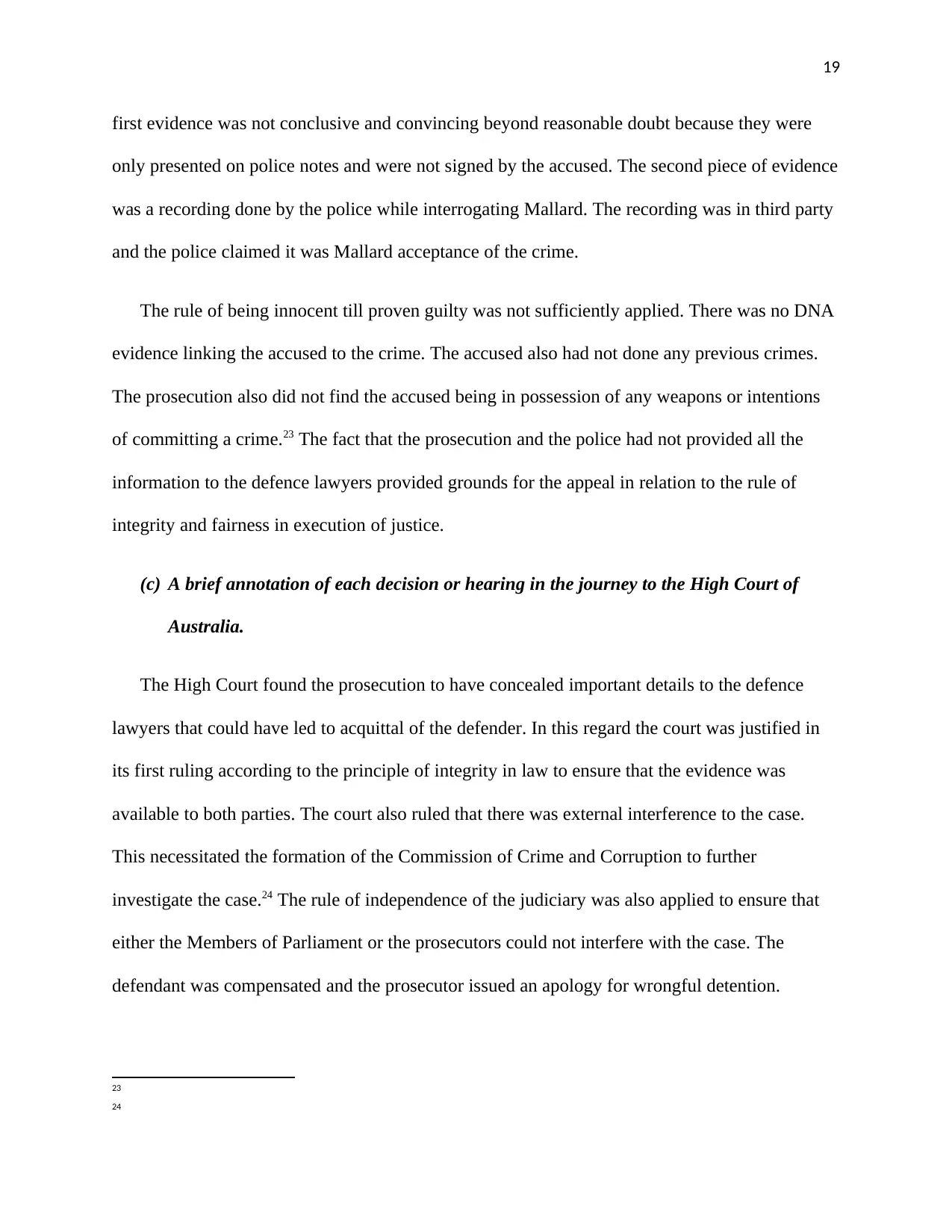
19
first evidence was not conclusive and convincing beyond reasonable doubt because they were
only presented on police notes and were not signed by the accused. The second piece of evidence
was a recording done by the police while interrogating Mallard. The recording was in third party
and the police claimed it was Mallard acceptance of the crime.
The rule of being innocent till proven guilty was not sufficiently applied. There was no DNA
evidence linking the accused to the crime. The accused also had not done any previous crimes.
The prosecution also did not find the accused being in possession of any weapons or intentions
of committing a crime.23 The fact that the prosecution and the police had not provided all the
information to the defence lawyers provided grounds for the appeal in relation to the rule of
integrity and fairness in execution of justice.
(c) A brief annotation of each decision or hearing in the journey to the High Court of
Australia.
The High Court found the prosecution to have concealed important details to the defence
lawyers that could have led to acquittal of the defender. In this regard the court was justified in
its first ruling according to the principle of integrity in law to ensure that the evidence was
available to both parties. The court also ruled that there was external interference to the case.
This necessitated the formation of the Commission of Crime and Corruption to further
investigate the case.24 The rule of independence of the judiciary was also applied to ensure that
either the Members of Parliament or the prosecutors could not interfere with the case. The
defendant was compensated and the prosecutor issued an apology for wrongful detention.
23
24
first evidence was not conclusive and convincing beyond reasonable doubt because they were
only presented on police notes and were not signed by the accused. The second piece of evidence
was a recording done by the police while interrogating Mallard. The recording was in third party
and the police claimed it was Mallard acceptance of the crime.
The rule of being innocent till proven guilty was not sufficiently applied. There was no DNA
evidence linking the accused to the crime. The accused also had not done any previous crimes.
The prosecution also did not find the accused being in possession of any weapons or intentions
of committing a crime.23 The fact that the prosecution and the police had not provided all the
information to the defence lawyers provided grounds for the appeal in relation to the rule of
integrity and fairness in execution of justice.
(c) A brief annotation of each decision or hearing in the journey to the High Court of
Australia.
The High Court found the prosecution to have concealed important details to the defence
lawyers that could have led to acquittal of the defender. In this regard the court was justified in
its first ruling according to the principle of integrity in law to ensure that the evidence was
available to both parties. The court also ruled that there was external interference to the case.
This necessitated the formation of the Commission of Crime and Corruption to further
investigate the case.24 The rule of independence of the judiciary was also applied to ensure that
either the Members of Parliament or the prosecutors could not interfere with the case. The
defendant was compensated and the prosecutor issued an apology for wrongful detention.
23
24
Paraphrase This Document
Need a fresh take? Get an instant paraphrase of this document with our AI Paraphraser
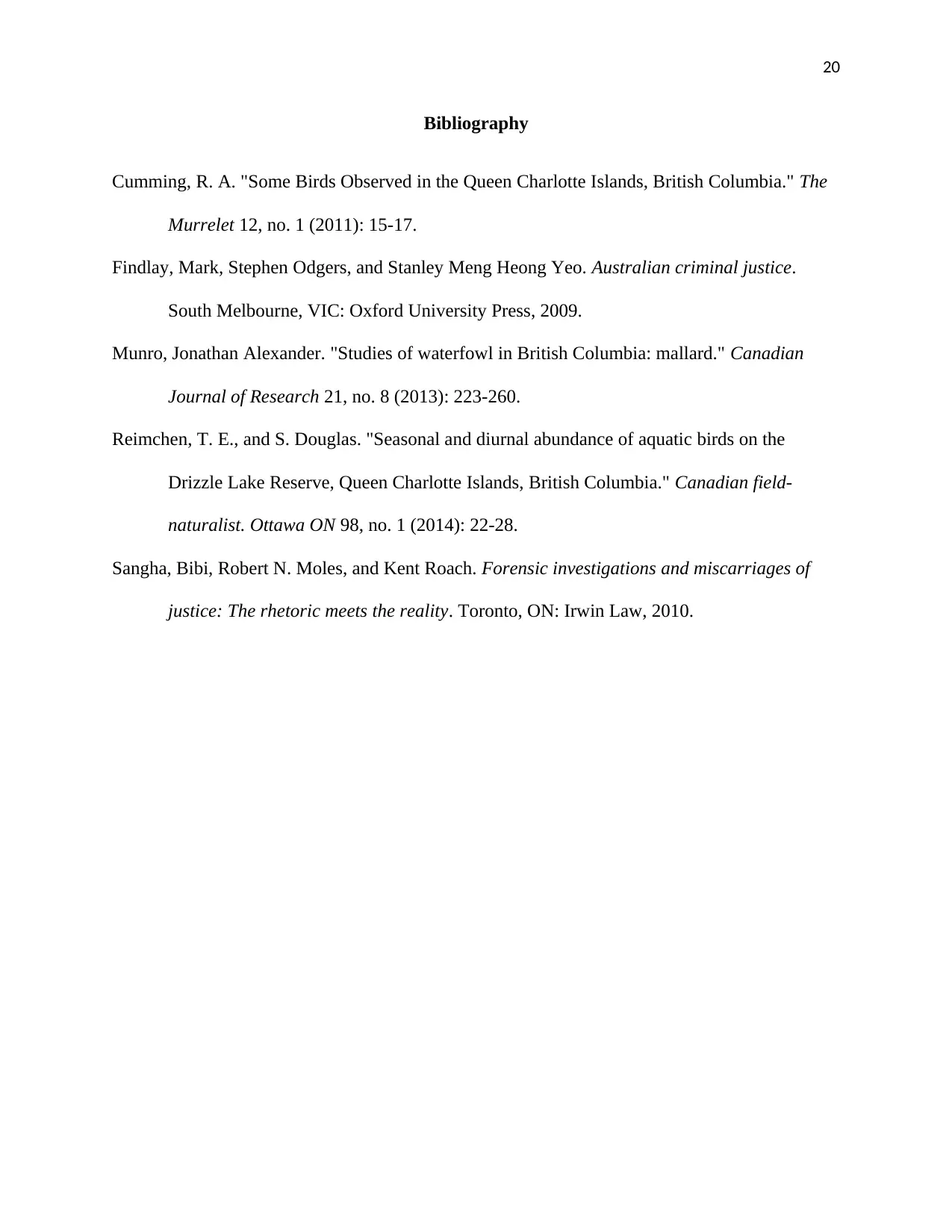
20
Bibliography
Cumming, R. A. "Some Birds Observed in the Queen Charlotte Islands, British Columbia." The
Murrelet 12, no. 1 (2011): 15-17.
Findlay, Mark, Stephen Odgers, and Stanley Meng Heong Yeo. Australian criminal justice.
South Melbourne, VIC: Oxford University Press, 2009.
Munro, Jonathan Alexander. "Studies of waterfowl in British Columbia: mallard." Canadian
Journal of Research 21, no. 8 (2013): 223-260.
Reimchen, T. E., and S. Douglas. "Seasonal and diurnal abundance of aquatic birds on the
Drizzle Lake Reserve, Queen Charlotte Islands, British Columbia." Canadian field-
naturalist. Ottawa ON 98, no. 1 (2014): 22-28.
Sangha, Bibi, Robert N. Moles, and Kent Roach. Forensic investigations and miscarriages of
justice: The rhetoric meets the reality. Toronto, ON: Irwin Law, 2010.
Bibliography
Cumming, R. A. "Some Birds Observed in the Queen Charlotte Islands, British Columbia." The
Murrelet 12, no. 1 (2011): 15-17.
Findlay, Mark, Stephen Odgers, and Stanley Meng Heong Yeo. Australian criminal justice.
South Melbourne, VIC: Oxford University Press, 2009.
Munro, Jonathan Alexander. "Studies of waterfowl in British Columbia: mallard." Canadian
Journal of Research 21, no. 8 (2013): 223-260.
Reimchen, T. E., and S. Douglas. "Seasonal and diurnal abundance of aquatic birds on the
Drizzle Lake Reserve, Queen Charlotte Islands, British Columbia." Canadian field-
naturalist. Ottawa ON 98, no. 1 (2014): 22-28.
Sangha, Bibi, Robert N. Moles, and Kent Roach. Forensic investigations and miscarriages of
justice: The rhetoric meets the reality. Toronto, ON: Irwin Law, 2010.
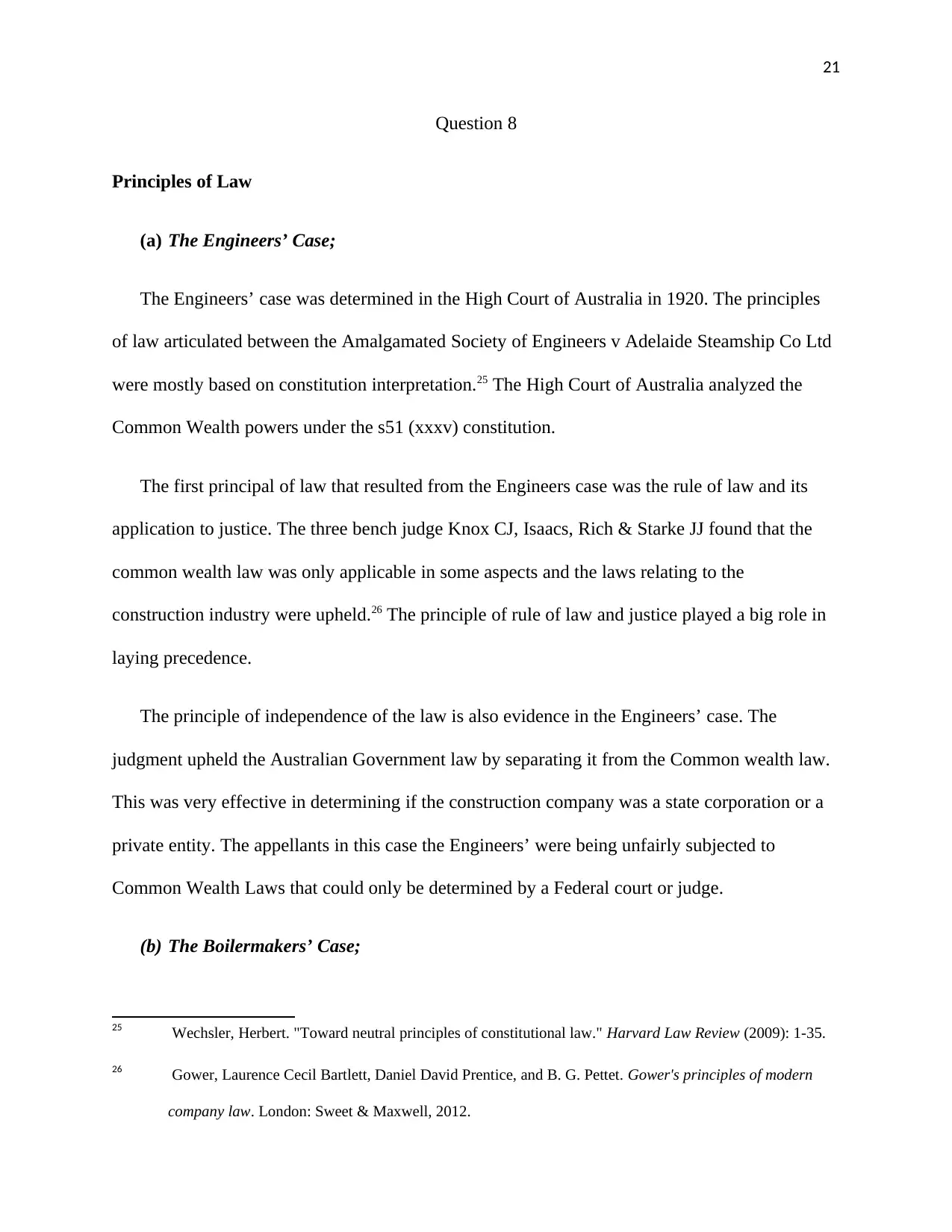
21
Question 8
Principles of Law
(a) The Engineers’ Case;
The Engineers’ case was determined in the High Court of Australia in 1920. The principles
of law articulated between the Amalgamated Society of Engineers v Adelaide Steamship Co Ltd
were mostly based on constitution interpretation.25 The High Court of Australia analyzed the
Common Wealth powers under the s51 (xxxv) constitution.
The first principal of law that resulted from the Engineers case was the rule of law and its
application to justice. The three bench judge Knox CJ, Isaacs, Rich & Starke JJ found that the
common wealth law was only applicable in some aspects and the laws relating to the
construction industry were upheld.26 The principle of rule of law and justice played a big role in
laying precedence.
The principle of independence of the law is also evidence in the Engineers’ case. The
judgment upheld the Australian Government law by separating it from the Common wealth law.
This was very effective in determining if the construction company was a state corporation or a
private entity. The appellants in this case the Engineers’ were being unfairly subjected to
Common Wealth Laws that could only be determined by a Federal court or judge.
(b) The Boilermakers’ Case;
25 Wechsler, Herbert. "Toward neutral principles of constitutional law." Harvard Law Review (2009): 1-35.
26 Gower, Laurence Cecil Bartlett, Daniel David Prentice, and B. G. Pettet. Gower's principles of modern
company law. London: Sweet & Maxwell, 2012.
Question 8
Principles of Law
(a) The Engineers’ Case;
The Engineers’ case was determined in the High Court of Australia in 1920. The principles
of law articulated between the Amalgamated Society of Engineers v Adelaide Steamship Co Ltd
were mostly based on constitution interpretation.25 The High Court of Australia analyzed the
Common Wealth powers under the s51 (xxxv) constitution.
The first principal of law that resulted from the Engineers case was the rule of law and its
application to justice. The three bench judge Knox CJ, Isaacs, Rich & Starke JJ found that the
common wealth law was only applicable in some aspects and the laws relating to the
construction industry were upheld.26 The principle of rule of law and justice played a big role in
laying precedence.
The principle of independence of the law is also evidence in the Engineers’ case. The
judgment upheld the Australian Government law by separating it from the Common wealth law.
This was very effective in determining if the construction company was a state corporation or a
private entity. The appellants in this case the Engineers’ were being unfairly subjected to
Common Wealth Laws that could only be determined by a Federal court or judge.
(b) The Boilermakers’ Case;
25 Wechsler, Herbert. "Toward neutral principles of constitutional law." Harvard Law Review (2009): 1-35.
26 Gower, Laurence Cecil Bartlett, Daniel David Prentice, and B. G. Pettet. Gower's principles of modern
company law. London: Sweet & Maxwell, 2012.
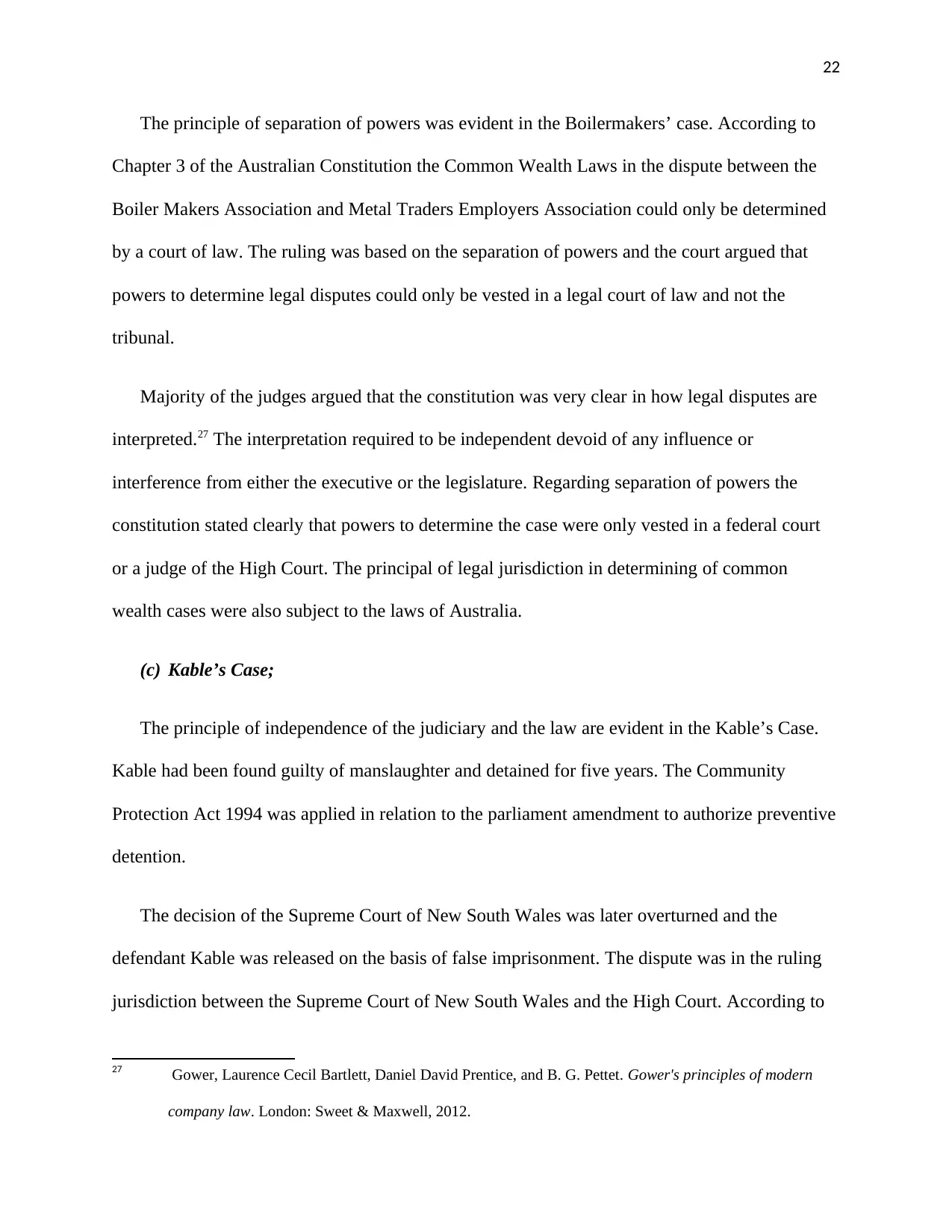
22
The principle of separation of powers was evident in the Boilermakers’ case. According to
Chapter 3 of the Australian Constitution the Common Wealth Laws in the dispute between the
Boiler Makers Association and Metal Traders Employers Association could only be determined
by a court of law. The ruling was based on the separation of powers and the court argued that
powers to determine legal disputes could only be vested in a legal court of law and not the
tribunal.
Majority of the judges argued that the constitution was very clear in how legal disputes are
interpreted.27 The interpretation required to be independent devoid of any influence or
interference from either the executive or the legislature. Regarding separation of powers the
constitution stated clearly that powers to determine the case were only vested in a federal court
or a judge of the High Court. The principal of legal jurisdiction in determining of common
wealth cases were also subject to the laws of Australia.
(c) Kable’s Case;
The principle of independence of the judiciary and the law are evident in the Kable’s Case.
Kable had been found guilty of manslaughter and detained for five years. The Community
Protection Act 1994 was applied in relation to the parliament amendment to authorize preventive
detention.
The decision of the Supreme Court of New South Wales was later overturned and the
defendant Kable was released on the basis of false imprisonment. The dispute was in the ruling
jurisdiction between the Supreme Court of New South Wales and the High Court. According to
27 Gower, Laurence Cecil Bartlett, Daniel David Prentice, and B. G. Pettet. Gower's principles of modern
company law. London: Sweet & Maxwell, 2012.
The principle of separation of powers was evident in the Boilermakers’ case. According to
Chapter 3 of the Australian Constitution the Common Wealth Laws in the dispute between the
Boiler Makers Association and Metal Traders Employers Association could only be determined
by a court of law. The ruling was based on the separation of powers and the court argued that
powers to determine legal disputes could only be vested in a legal court of law and not the
tribunal.
Majority of the judges argued that the constitution was very clear in how legal disputes are
interpreted.27 The interpretation required to be independent devoid of any influence or
interference from either the executive or the legislature. Regarding separation of powers the
constitution stated clearly that powers to determine the case were only vested in a federal court
or a judge of the High Court. The principal of legal jurisdiction in determining of common
wealth cases were also subject to the laws of Australia.
(c) Kable’s Case;
The principle of independence of the judiciary and the law are evident in the Kable’s Case.
Kable had been found guilty of manslaughter and detained for five years. The Community
Protection Act 1994 was applied in relation to the parliament amendment to authorize preventive
detention.
The decision of the Supreme Court of New South Wales was later overturned and the
defendant Kable was released on the basis of false imprisonment. The dispute was in the ruling
jurisdiction between the Supreme Court of New South Wales and the High Court. According to
27 Gower, Laurence Cecil Bartlett, Daniel David Prentice, and B. G. Pettet. Gower's principles of modern
company law. London: Sweet & Maxwell, 2012.
Secure Best Marks with AI Grader
Need help grading? Try our AI Grader for instant feedback on your assignments.

23
Chapter three of the Australian constitution, the Supreme Court of New South Wales was found
to have erred in judgement and its ruling was overturned. This was in principle to the
independence of the law against any external influence.
Chapter three of the Australian constitution, the Supreme Court of New South Wales was found
to have erred in judgement and its ruling was overturned. This was in principle to the
independence of the law against any external influence.
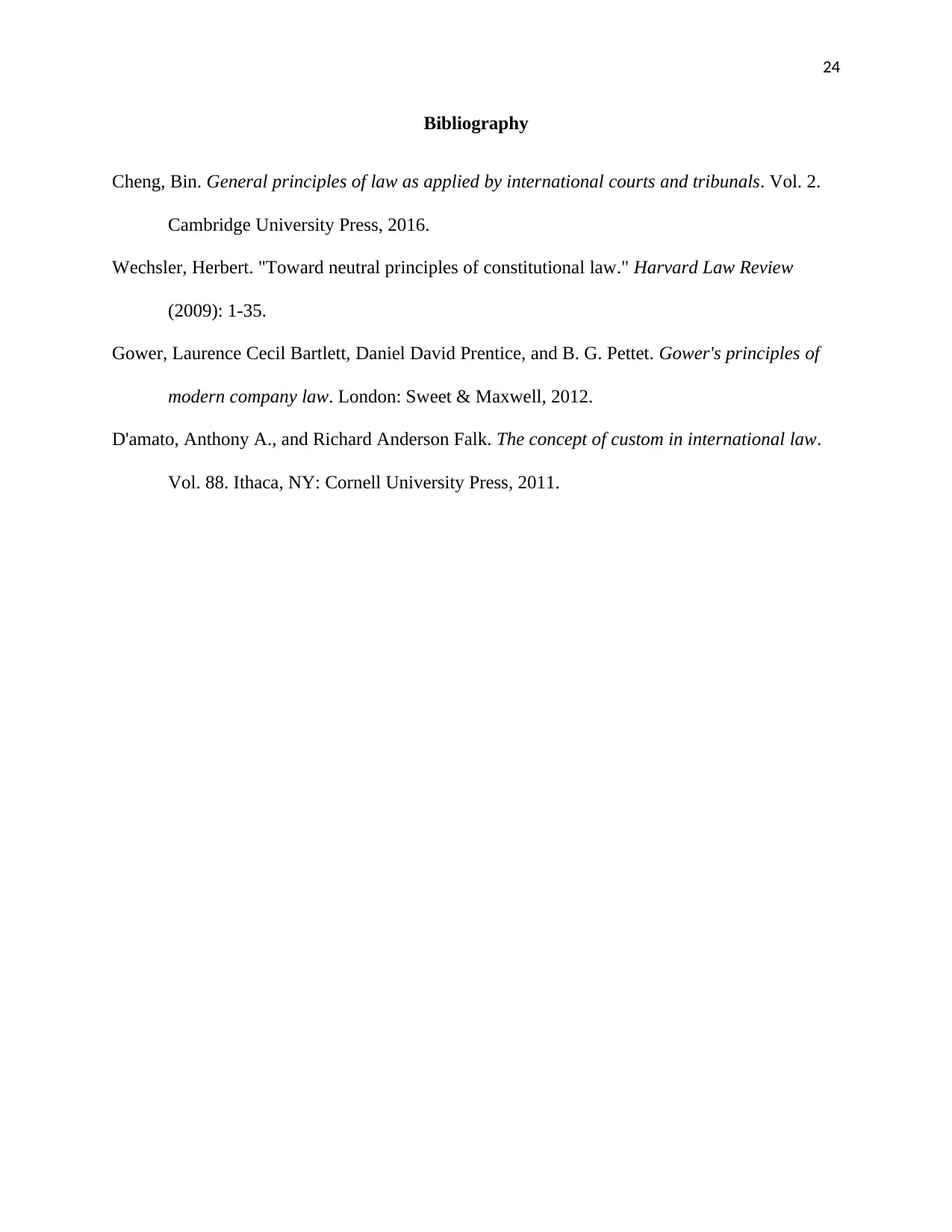
24
Bibliography
Cheng, Bin. General principles of law as applied by international courts and tribunals. Vol. 2.
Cambridge University Press, 2016.
Wechsler, Herbert. "Toward neutral principles of constitutional law." Harvard Law Review
(2009): 1-35.
Gower, Laurence Cecil Bartlett, Daniel David Prentice, and B. G. Pettet. Gower's principles of
modern company law. London: Sweet & Maxwell, 2012.
D'amato, Anthony A., and Richard Anderson Falk. The concept of custom in international law.
Vol. 88. Ithaca, NY: Cornell University Press, 2011.
Bibliography
Cheng, Bin. General principles of law as applied by international courts and tribunals. Vol. 2.
Cambridge University Press, 2016.
Wechsler, Herbert. "Toward neutral principles of constitutional law." Harvard Law Review
(2009): 1-35.
Gower, Laurence Cecil Bartlett, Daniel David Prentice, and B. G. Pettet. Gower's principles of
modern company law. London: Sweet & Maxwell, 2012.
D'amato, Anthony A., and Richard Anderson Falk. The concept of custom in international law.
Vol. 88. Ithaca, NY: Cornell University Press, 2011.
1 out of 24
Your All-in-One AI-Powered Toolkit for Academic Success.
+13062052269
info@desklib.com
Available 24*7 on WhatsApp / Email
![[object Object]](/_next/static/media/star-bottom.7253800d.svg)
Unlock your academic potential
© 2024 | Zucol Services PVT LTD | All rights reserved.